MyBatis学习
【免责说明】笔者是看了狂神的视频,边学习,边做笔记,由于水平有限,大部分都是借鉴下来的。如有侵权,速速联系我。
1.简介
1.1 是什么?

- MyBatis 是一款优秀的持久层框架
- 它支持定制化 SQL、存储过程以及高级映射。
- MyBatis 避免了几乎所有的 JDBC 代码和手动设置参数以及获取结果集。
- MyBatis 可以使用简单的 XML 或注解来配置和映射原生类型、接口和 Java 的 POJO(Plain Old Java Objects,普通老式 Java 对象)为数据库中的记录。
- MyBatis 本是apache的一个开源项目iBatis, 2010年这个项目由apache software foundation 迁移到了google code,并且改名为MyBatis 。
- 2013年11月迁移到Github。
如何获得Mybatis?
- Maven依赖:
<dependency><groupId>org.mybatis</groupId><artifactId>mybatis</artifactId><version>3.5.3</version></dependency>
- Github:https://github.com/mybatis/mybatis-3/releases/
- 官方文档:https://mybatis.org/mybatis-3/zh/getting-started.html
1.2、持久化
数据持久化
- 持久化就是将程序的数据在持久状态和瞬时状态转化的过程
- 内存:断电即失
- 数据库(Jdbc),io文件持久化。
- 生活:冷藏. 罐头。
为什么需要需要持久化?
- 有一些对象,不能让他丢掉。
- 内存太贵了
1.3、持久层
Dao层,Service层,Controller层….
- 完成持久化工作的代码块
- 层界限十分明显。
1.4 为什么需要Mybatis?
- 帮助程序猿将数据存入到数据库中。
- 方便
- 传统的JDBC代码太复杂了。简化。框架。自动化。
- 不用Mybatis也可以。更容易上手。 技术没有高低之分
- 优点:
- 简单易学
- 灵活
- sql和代码的分离,提高了可维护性。
- 提供映射标签,支持对象与数据库的orm字段关系映射
- 提供对象关系映射标签,支持对象关系组建维护
- 提供xml标签,支持编写动态sql。
最重要的一点:使用的人多!
Spring SpringMVC SpringBoot
2、Hello Mybatis
思路:搭建环境-->导入Mybatis-->编写代码-->测试!
2.1 搭建环境
1.创建数据库
CREATE DATABASE `mybatis`;USE `mybatis`CREATE TABLE `user`(`id` INT(20) NOT NULL PRIMARY KEY COMMENT '用户id',`name` VARCHAR(30) DEFAULT NULL,`pwd` VARCHAR(30) DEFAULT NULL)ENGINE=INNODB DEFAULT CHARSET=utf8;INSERT INTO `user` (`id`,`name`,`pwd`) VALUES(1,'陈66','123456'),(2,'至尊宝','5201314'),(3,'紫霞','666666');
2.新建一个maven项目
项目结构如下:
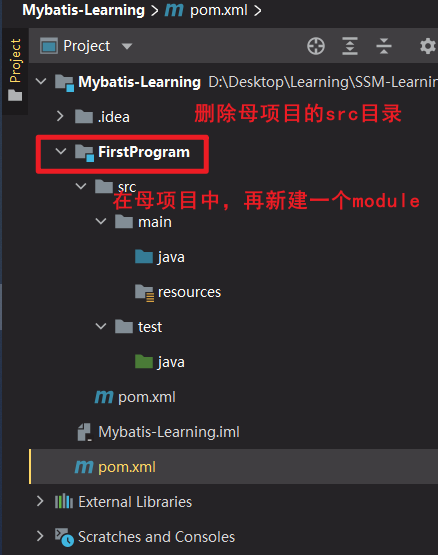
导入maven依赖
<dependencies><dependency><groupId>org.mybatis</groupId><artifactId>mybatis</artifactId><version>3.5.6</version></dependency><dependency><groupId>mysql</groupId><artifactId>mysql-connector-java</artifactId><version>8.0.20</version></dependency><dependency><groupId>junit</groupId><artifactId>junit</artifactId><version>4.13</version><scope>test</scope></dependency></dependencies>
2.2 mybatis配置准备
编写mybatis的核心配置文件
在resources目录下,新建一个xml文件,命名为:mybatis-config.xml<?xml version="1.0" encoding="UTF-8" ?><!DOCTYPE configurationPUBLIC "-//mybatis.org//DTD Config 3.0//EN""http://mybatis.org/dtd/mybatis-3-config.dtd"><!--configuration核心配置文件--><configuration><environments default="development"><environment id="development"><transactionManager type="JDBC"/><dataSource type="POOLED"><property name="driver" value="com.mysql.cj.jdbc.Driver"/><property name="url" value="jdbc:mysql://localhost:3306/mybatis?serverTimezone=Asia/Shanghai&useSSL=true&useUnicode=true&characterEncoding=UTF-8"/><property name="username" value="root"/><property name="password" value="root"/></dataSource></environment></environments></configuration>
编写mybatis工具类 ```java package com.chen66.utils;
import org.apache.ibatis.io.Resources; import org.apache.ibatis.session.SqlSession; import org.apache.ibatis.session.SqlSessionFactory; import org.apache.ibatis.session.SqlSessionFactoryBuilder;
import java.io.IOException; import java.io.InputStream;
public class MybatisUtil { static private SqlSessionFactory sqlSessionFactory; static { try { //使用Mybatis第一步:获取sqlSessionFactory对象 String resource = “mybatis-config.xml”; InputStream inputStream =Resources.getResourceAsStream(resource); sqlSessionFactory = new SqlSessionFactoryBuilder().build(inputStream); } catch (IOException e) { e.printStackTrace(); }
}//既然有了 SqlSessionFactory,顾名思义,我们就可以从中获得 SqlSession 的实例了。// SqlSession 完全包含了面向数据库执行 SQL 命令所需的所有方法。public static SqlSession getSqlSessionFactory(){return sqlSessionFactory.openSession();}
}
<a name="a060729b"></a>### 2.3 具体实现代码- POJO类<br />User.java```javapackage com.chen66.pojo;public class User {private int id;private String name;private String pwd;public User() {}public User(int id, String name, String pwd) {this.id = id;this.name = name;this.pwd = pwd;}public int getId() {return id;}public void setId(int id) {this.id = id;}public String getName() {return name;}public void setName(String name) {this.name = name;}public String getPwd() {return pwd;}public void setPwd(String pwd) {this.pwd = pwd;}@Overridepublic String toString() {return "User{" +"id=" + id +", name='" + name + '\'' +", pwd='" + pwd + '\'' +'}';}}
- Dao接口 ```java package com.chen66.dao;
import com.chen66.pojo.User;
import java.util.List;
public interface UserDao {
List
- 接口实现类由原来的UserDaoImpl转变为一个 Mapper配置文件.```xml<?xml version="1.0" encoding="UTF-8" ?><!DOCTYPE mapperPUBLIC "-//mybatis.org//DTD Mapper 3.0//EN""http://mybatis.org/dtd/mybatis-3-mapper.dtd"><mapper namespace="com.chen66.dao.UserDao"><select id="getUserLists" resultType="com.chen66.pojo.User">select * from mybatis.user</select></mapper>
2.4 测试
Junit测试:
package com.chen66;import com.chen66.dao.UserDao;import com.chen66.pojo.User;import com.chen66.utils.MybatisUtil;import org.apache.ibatis.session.SqlSession;import org.junit.Test;import java.util.List;public class Mytest {@Testpublic void Test01(){//第一步:获取sqlSession对象SqlSession sqlSession = MybatisUtil.getSqlSession();UserDao mapper = sqlSession.getMapper(UserDao.class);List<User> userLists = mapper.getUserLists();for (User userList : userLists) {System.out.println(userList);}sqlSession.close();}}
运行结果:

报错?
注意:org.apache.ibatis.binding.BindingException: Type interface com.chen66.dao.UserDao is not known to the MapperRegistry.
这里查看一下,官方文档:
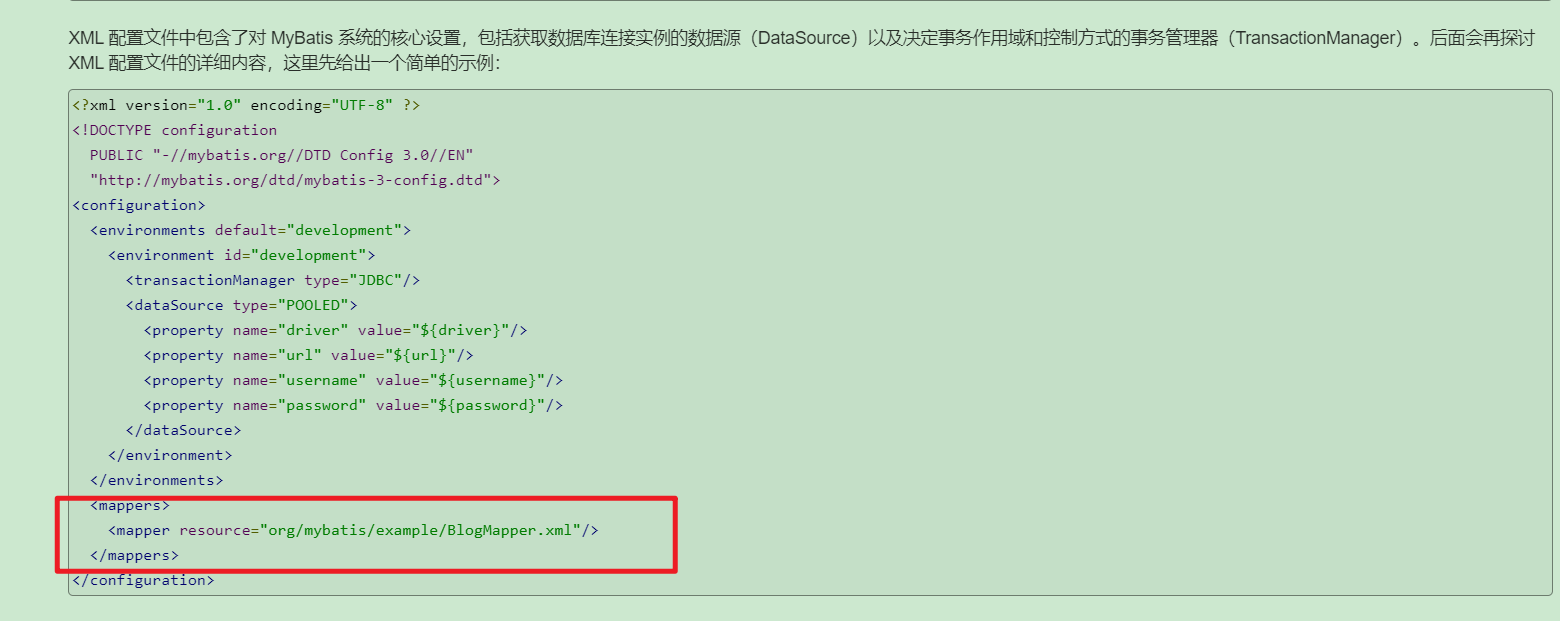
解决方法:
核心配置文件(mybatis-config.xml)中注册 mappers
<mappers><mapper resource="com/chen66/dao/UserMapper.xml"/></mappers>
再次运行:
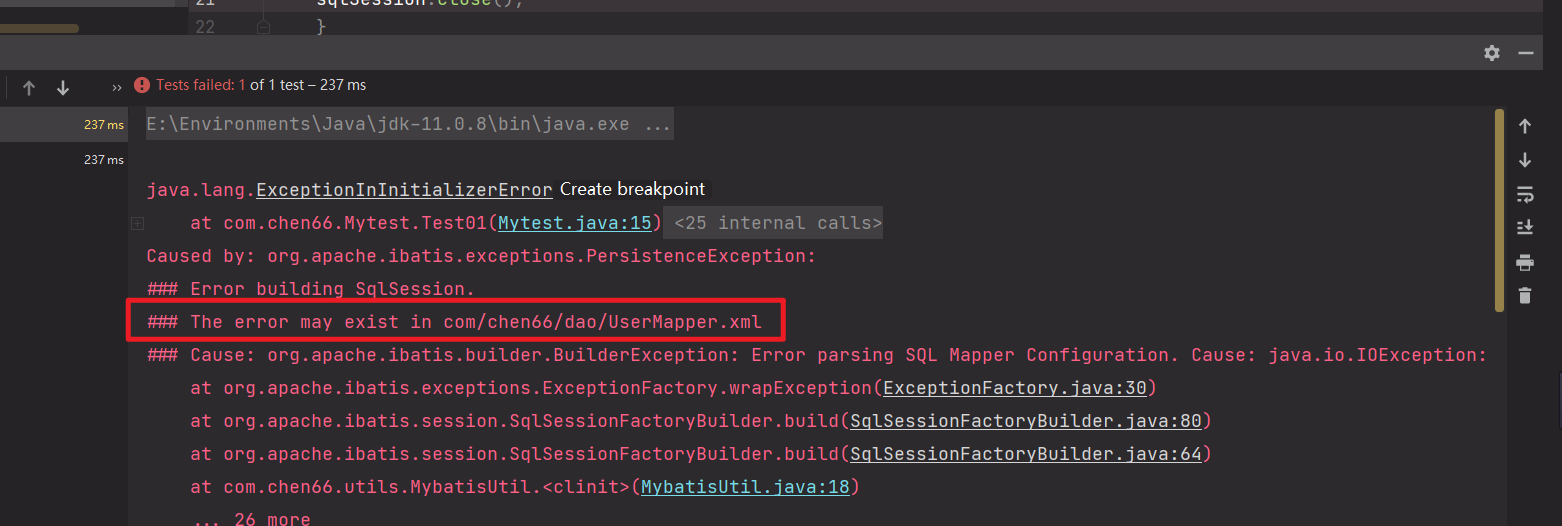
???### The error may exist in com/chen66/dao/UserMapper.xml
嘿嘿,是不是经常忘记?maven的约定大于配置。
这明显就是资源导出的问题。
解决方法:
在pom.xml中加入如下配置代码,解决资源过滤问题。
<build><resources><resource><directory>src/main/resources</directory><includes><include>**/*.properties</include><include>**/*.xml</include></includes><filtering>true</filtering></resource><resource><directory>src/main/java</directory><includes><include>**/*.properties</include><include>**/*.xml</include></includes><filtering>true</filtering></resource></resources></build>
再次运行:
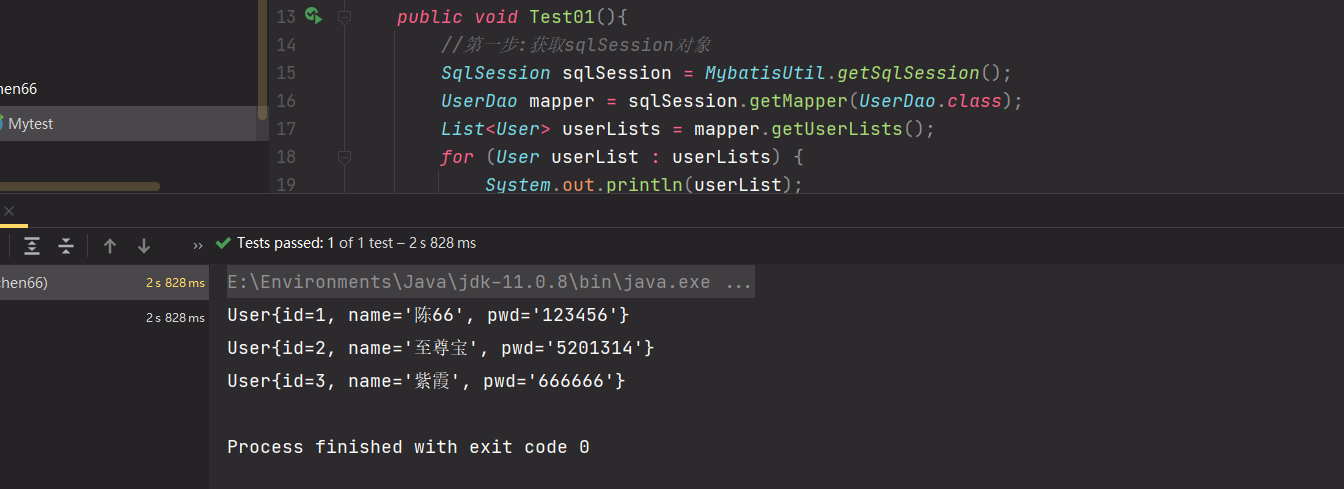
ok!
3、CRUD
1、Namespace
namespace中的包名要和 Dao/mapper 接口的包名一致!
2、Select
选择,查询语句;
- id : 就是对应的namespace中的方法名;
- resultType:Sql语句执行的返回值!
- parameterType : 参数类型!
1.编写接口
//根据ID查询用户User getUserById(int id);
2.编写Mapper.xml
<select id="getUserById" resultType="com.chen66.pojo.User">select * from user where id=#{id}</select>
3.编写测试类
@Testpublic void Test02(){SqlSession sqlSession = MybatisUtil.getSqlSession();UserDao mapper = sqlSession.getMapper(UserDao.class);User userById = mapper.getUserById(2);System.out.println(userById);sqlSession.close();}
运行结果:

3、Insert
1.接口:
//插入一个新用户//注意这里的参数传入类型是User而不是id,name,pwdint InsertUser(int id,String name,String pwd);
2.Mapper
<insert id="InsertUser" parameterType="com.chen66.pojo.User">insert into user (id, name, pwd) VALUES (#{id},#{name},#{pwd});</insert>
3.测试类:
@Testpublic void TestAdd(){SqlSession sqlSession = MybatisUtil.getSqlSession();UserDao mapper = sqlSession.getMapper(UserDao.class);int i = mapper.InsertUser(5, "澜", "666666");if (i>0){System.out.println("插入成功!");}sqlSession.close();}
运行结果:

这种错误一般是参数类型不一致,要思考接口的参数类型,是否与Mapper的相匹配,明明Mapper的parameterType是User,但我们的接口传入的是id,name,pwd,没有pojo类与之匹配。
将接口的参数类型改成User即可
int InsertUser(User user);
测试类也要做相应的修改:
User user = new User(5, "澜", "666666");int i = mapper.InsertUser(user);
其他不变。
运行结果:
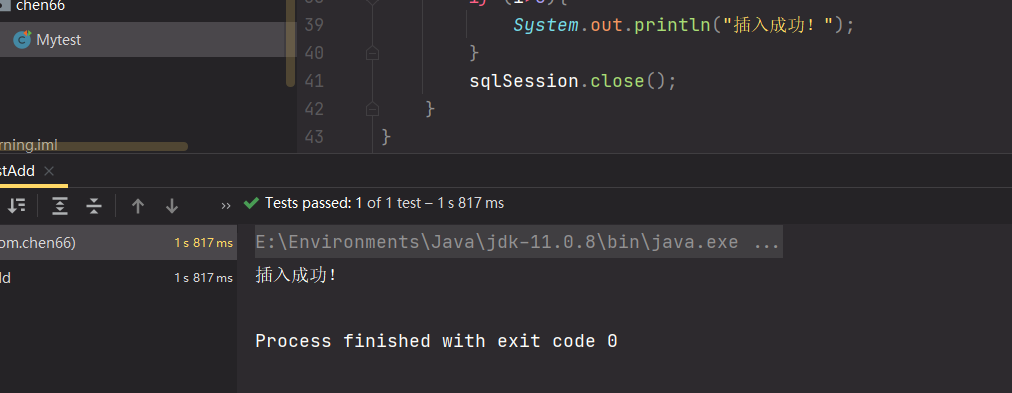
你以为插入成功了吗?那到底有没有成功呢?查看数据库表不就行了吗?
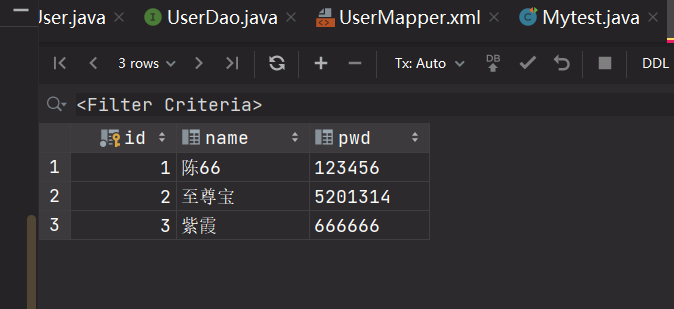
发现,并没有成功啊!这是为啥?明明运行成功了!
如果你也有相同的问题,说明数据库的知识没有掌握好。
增删改的时候,一定要提交事务,不然信息不能同步。
测试类中加入如下代码。提交事务
//一定要提交事务,不然数据不能同步sqlSession.commit();
再次运行:

刷新数据库表,查看:

ok,插入成功!
4、Update
1.接口:
//修改用户信息int updateUser(User user);
2.Mapper
<update id="updateUser" parameterType="com.chen66.pojo.User">update userset name=#{name},pwd=#{pwd}where id=#{id};</update>
3.测试类:
@Testpublic void TestUpdate(){SqlSession sqlSession = MybatisUtil.getSqlSession();UserDao mapper = sqlSession.getMapper(UserDao.class);User user = new User(5,"大圣娶妻","999999");int i = mapper.updateUser(user);if (i>0){System.out.println("修改成功!");}sqlSession.commit();sqlSession.close();}
运行结果:
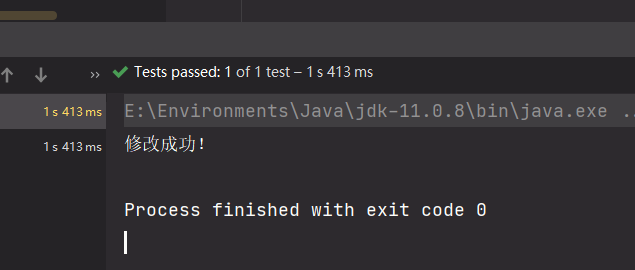
5、Delete
接口:
//删除一个用户信息int deleteUser(int id);
Mapper
<delete id="deleteUser" parameterType="int">delete from user where id=#{id};</delete>
测试类:
@Testpublic void TestDelete(){SqlSession sqlSession = MybatisUtil.getSqlSession();UserDao mapper = sqlSession.getMapper(UserDao.class);int i = mapper.deleteUser(5);if (i>0){System.out.println("删除成功!!!");}sqlSession.commit();sqlSession.close();}}
运行结果:

- 注意点:
增删改查需要提交事务
6、常见错误
- 标签不要匹配错
- resource 绑定mapper,需要使用路径!
- 程序配置文件必须符合规范!
- NullPointerException,没有注册到资源!
- 输出的xml文件中存在中文乱码问题!
- maven资源没有导出问题!
小提示:如果程序报错了,分析错误,要从下往上读
7、万能Map
假设,我们的实体类,或者数据库中的表,字段或者参数过多,我们应当考虑使用Map!
改造InsertUser
int InsertUser2(Map<String,Object> map);
Mapper
<insert id="InsertUser2" parameterType="map">insert into user (id, name, pwd) VALUES (#{mid},#{mname},#{mpwd});</insert>
测试类:
@Testpublic void TestAdd2(){SqlSession sqlSession = MybatisUtil.getSqlSession();UserDao mapper = sqlSession.getMapper(UserDao.class);Map<String, Object> map = new HashMap<String,Object>();map.put("mid",6);map.put("mname","薛之谦");map.put("mpwd","666");int i = mapper.InsertUser2(map);if (i>0){System.out.println("插入成功!");}//一定要提交事务,不然数据不能同步sqlSession.commit();sqlSession.close();}
Map传递参数,直接在sql中取出key即可! 【parameterType=”map”】
对象传递参数,直接在sql中取对象的属性即可!【parameterType=”Object”】
只有一个基本类型参数的情况下,可以直接在sql中取到!
多个参数用Map,或者注解!
8.模糊查询
为了模糊查询,插入两个用户信息:
insert into user (id, name, pwd)values (5,'李六','123456'),(7,'李四','123456');
接口:
List<User> getUserListLike(String value);
思路:
1.在java中传递%%通配符
测试类中:
List<User> list = mapper.getUserListLike("%李%");
Mapper
<select id="getUserListLike" resultType="com.chen66.pojo.User">select * from user where name like #{value};</select>
运行结果:
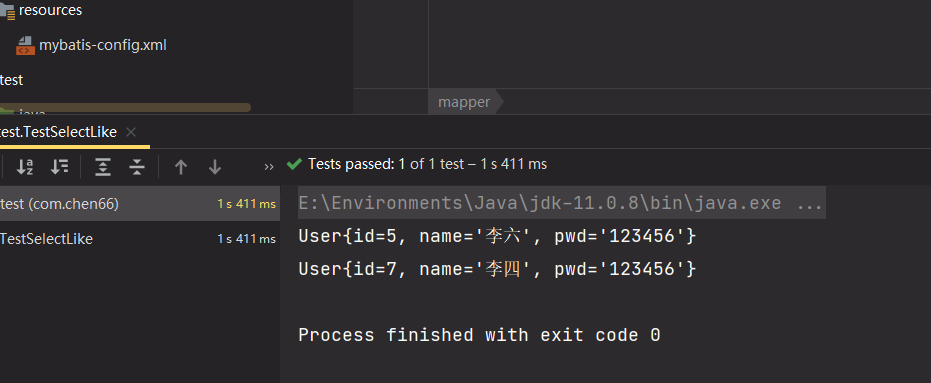
2.在sql拼接中使用通配符
<select id="getUserListLike" resultType="com.chen66.pojo.User">select * from user where name like "%"#{value}"%";</select>
测试类:
@Testpublic void TestSelectLike(){SqlSession sqlSession = MybatisUtil.getSqlSession();UserDao mapper = sqlSession.getMapper(UserDao.class);List<User> list = mapper.getUserListLike("李");for (User user : list) {System.out.println(user);}sqlSession.close();}
运行结果:
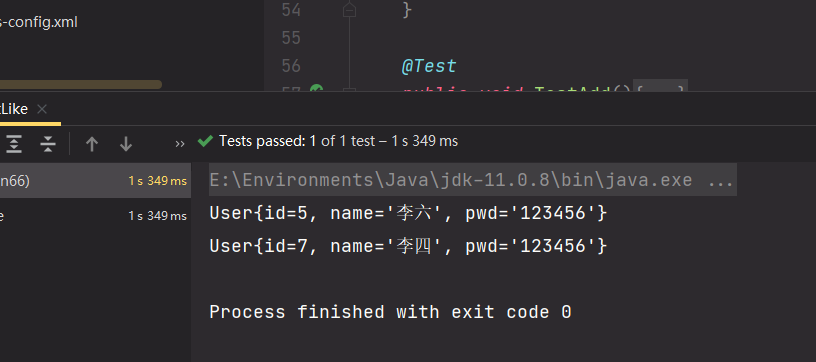
4、配置解析
1、核心配置文件
mybatis-config.xml
MyBatis 的配置文件包含了会深深影响 MyBatis 行为的设置和属性信息。 配置文档的顶层结构如下:
- configuration(配置)
- properties(属性)
- settings(设置)
- typeAliases(类型别名)
- typeHandlers(类型处理器)
- objectFactory(对象工厂)
- plugins(插件)
- environments(环境配置)
- environment(环境变量)
- transactionManager(事务管理器)
- dataSource(数据源)
- environment(环境变量)
- databaseIdProvider(数据库厂商标识)
- mappers(映射器)
2、环境配置(environments)
MyBatis 可以配置成适应多种环境。
不过要记住:尽管可以配置多个环境,但每个 SqlSessionFactory 实例只能选择一种环境。
每个数据库对应一个 SqlSessionFactory 实例
Mybatis默认的事务管理器就是 JDBC , 连接池 : POOLED
3、属性(Properties)
我们可以通过properties属性来实现引用配置文件
这些属性都是可外部配置且可动态替换的,既可以在典型的 Java 属性文件中配置,亦可通过 properties 元素的子元素来传递。【db.properties】

properties标签放在configuration的第一个
编写一个配置文件db.properties
driver=com.mysql.cj.jdbc.Driverurl=jdbc:mysql://localhost:3306/mybatis?serverTimezone=Asia/Shanghai&useSSL=true&useUnicode=true&characterEncoding=UTF-8username=rootpassword=111111
mybaties.xml
<?xml version="1.0" encoding="UTF-8" ?><!DOCTYPE configurationPUBLIC "-//mybatis.org//DTD Config 3.0//EN""http://mybatis.org/dtd/mybatis-3-config.dtd"><!--configuration核心配置文件--><configuration><properties resource="db.properties"><!-- 这里的密码写正确,外部的密码故意错误,看能否成功,可以测试谁的优先级高!--><property name="username" value="root"/><property name="password" value="root"/></properties><environments default="development"><environment id="development"><transactionManager type="JDBC"/><dataSource type="POOLED"><property name="driver" value="${driver}"/><property name="url" value="${url}"/><property name="username" value="${username}"/><property name="password" value="${password}"/></dataSource></environment></environments><mappers><mapper resource="com/chen66/dao/UserMapper.xml"/></mappers></configuration>
运行测试类:
密码错误,证明外部的优先级比内嵌的property属性要高
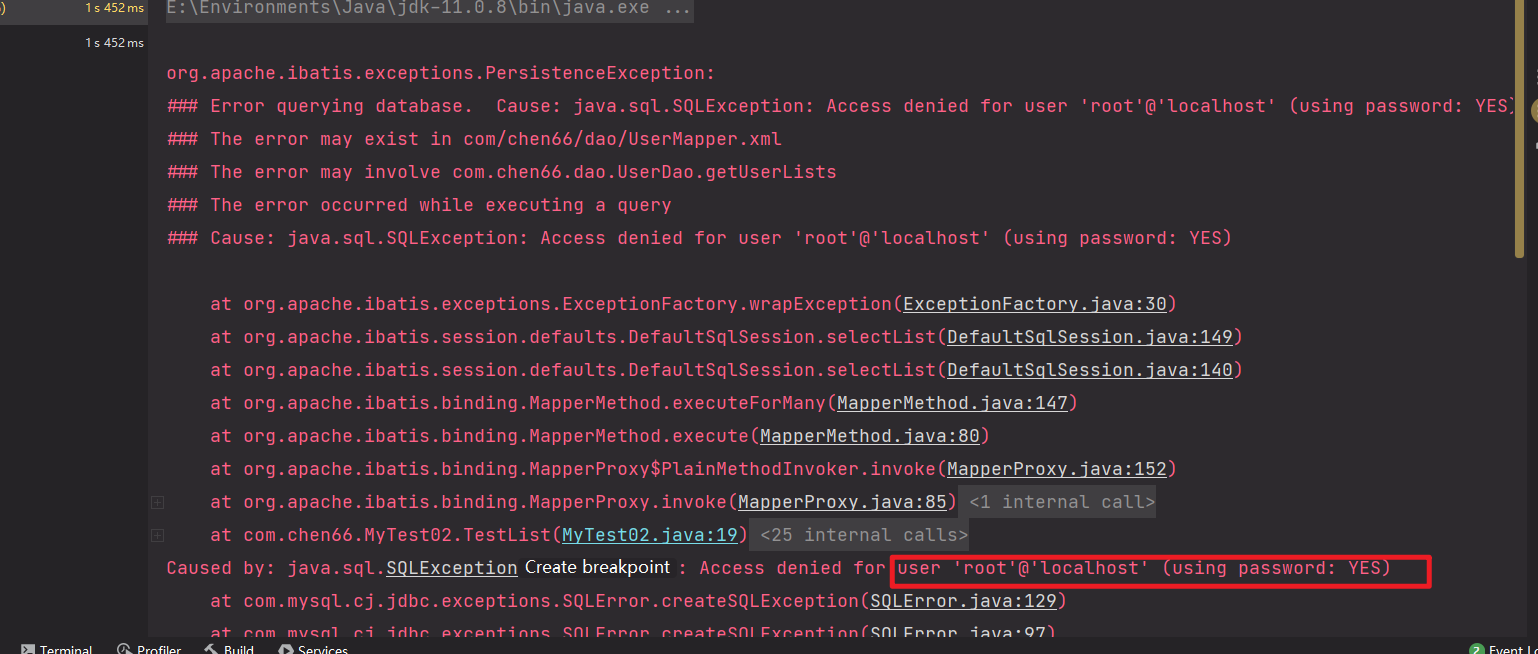
对换一下:内部密码改为111111,外部的db.properties的password改为root
再次运行:
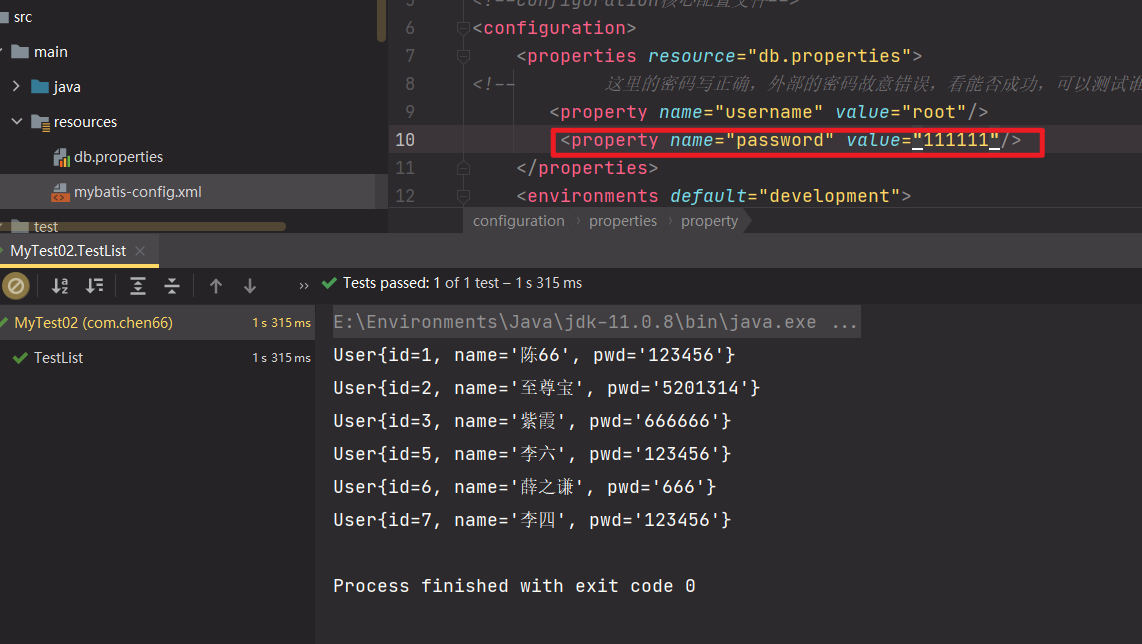
总结:
- 可以直接引入外部文件
- 可以在其中增加一些属性配置
- 如果两个文件有同一个字段,优先使用外部配置文件的!
4、类型别名(typeAliases)
类型别名可为 Java 类型设置一个缩写名字。
它仅用于 XML 配置,意在降低冗余的全限定类名书写
在mybatis-config.xml中配置
<!-- 给实体类起别名--><typeAliases><typeAlias alias="User" type="com.chen66.pojo.User" /></typeAliases>
这时在mapper.xml中可直接使用别名。
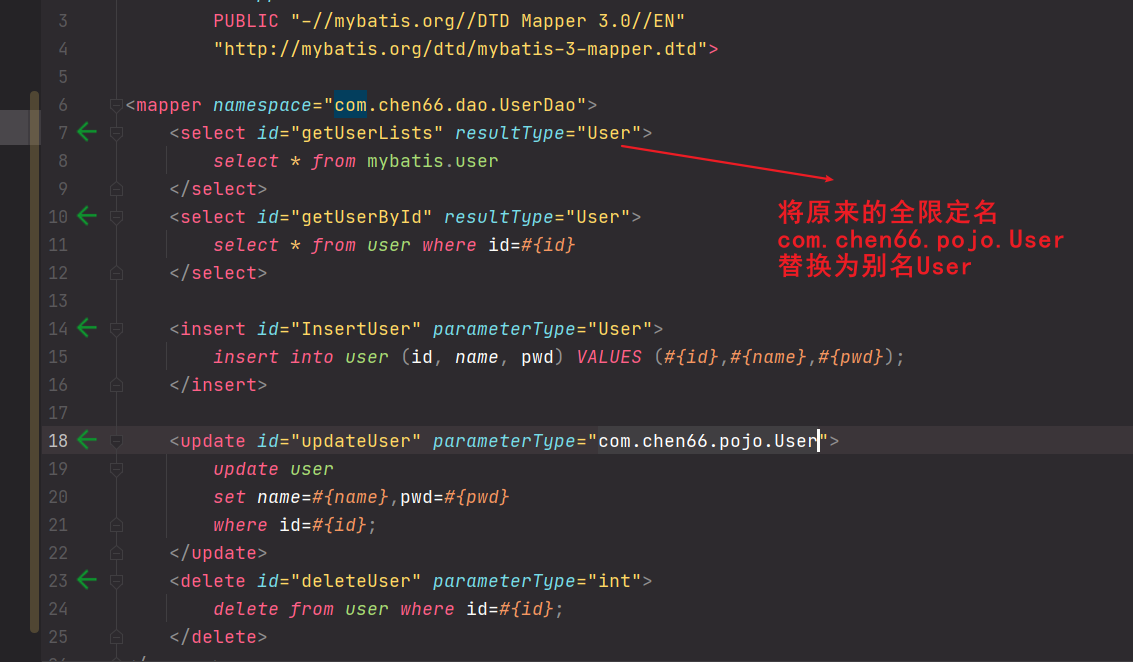
也可以指定一个包名,MyBatis 会在包名下面搜索需要的 Java Bean,比如:
扫描实体类的包,它的默认别名就为这个类的 类名,首字母小写!
<typeAliases><package name="com.chen66.pojo"/></typeAliases>
小提示:
- 在实体类比较少的时候,使用第一种方式。
- 如果实体类十分多,建议使用第二种。
- 第一种可以DIY别名,第二种则·不行·,如果非要改,需要在实体上增加注解
@Alias("user")public class User {}
5、设置
这是 MyBatis 中极为重要的调整设置,它们会改变 MyBatis 的运行时行为。


6、其他配置
- typeHandlers(类型处理器)
- objectFactory(对象工厂)
- plugins插件
- mybatis-generator-core
- mybatis-plus
- 通用mapper
7、映射器(mappers)
MapperRegistry:注册绑定Mapper文件
方式一:资源绑定【推荐使用】
<!--每一个Mapper.XML都需要在Mybatis核心配置文件中注册!--><mappers><mapper resource="com/chen66/dao/UserMapper.xml"/></mappers>
方式二:类绑定
<mappers><mapper class="com.chen66.dao.UserMapper"/></mappers>
方式三:包扫描绑定
<mappers><package name="com.chen66.dao"/></mappers>
注意点:
- 接口和Mapper必须同名
- 接口和Mapper必须在同一个包下
8、作用域(Scope)和生命周期
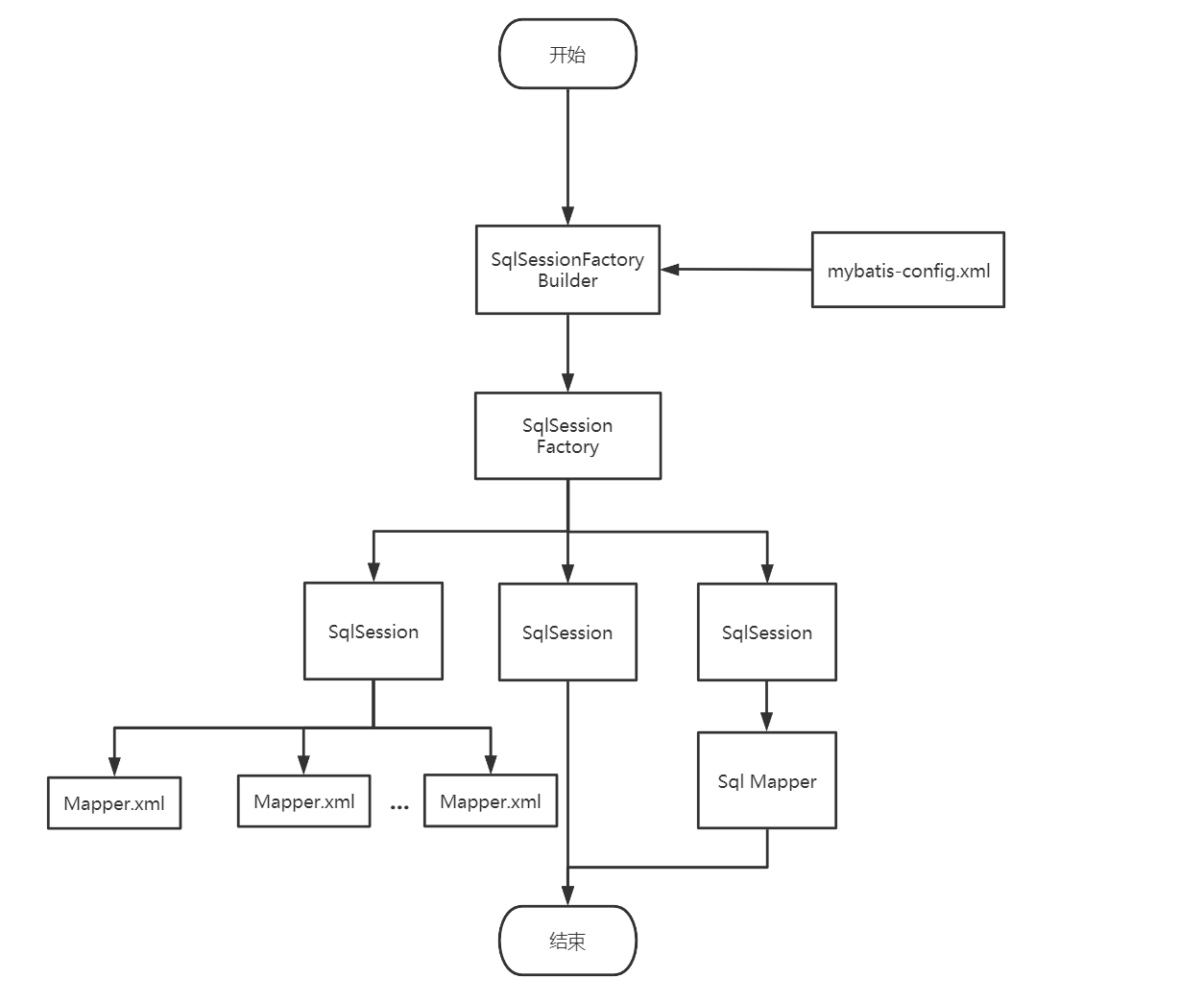
错误的使用会导致非常严重的并发问题。
SqlSessionFactoryBuilder
- 一旦创建了 SqlSessionFactory,就不再需要
- 局部方法变量。
- 可以重用 SqlSessionFactoryBuilder 来创建多个 SqlSessionFactory 实例,类似于数据库连接池。
SqlSessionFactory
- 一旦被创建就应该在应用的运行期间一直存在,不要重复创建多次。
- 最佳作用域是应用作用域(全局)
- 使用单例模式或者静态单例模式。
SqlSession
- 每个线程都应该有它自己的 SqlSession 实例。
- 连接到连接池的一个请求
- SqlSession 的实例不是线程安全的,不能被共享。
- 最佳的作用域是请求或方法作用域。
- 用完赶紧关闭,释放资源
5、解决属性名和字段名不一致的问题
5.1、问题引入:
表结构:

新建一个项目,拷贝之前的相关文件,修改POJO类中的password字段名,使其字段名与数据表中的字段名不一致,进行测试。
public class User {private int id;private String name;private String password;}
运行结果:
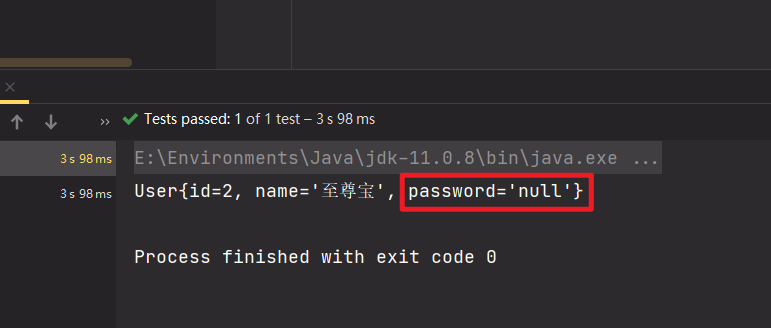
发现password中的值为空。
这就出现了属性名和字段名不一致,导致映射的结果出现问题了。
// select * from mybatis.user where id = #{id}//类型处理器select id,name,pwd as password from user where id=#{id}
解决方法:
1、起别名
将mapper中的语句修改下:
select id,name,pwd as password from user where id=#{id}
2、使用结果集映射 resultMap
5.2、结果集映射 resultMap
ResultMap 的设计思想:对简单的语句做到零配置,对于复杂一点的语句,只需要描述语句之间的关系就行了。
<resultMap id="UserMap" type="User"><result column="id" property="id"/><result column="name" property="name"/><result column="pwd" property="password"/></resultMap>
这里需要注意一个问题,resultMap的id 一定要引入到select的标签中,不然查询出来的结果集映不知道去哪里找。而且也不报错,依然能查出来,只不过如果查询字段不一致的数据是,结果为空。当resultType和resultMap都存在时,resultMap的优先级更高.
<select id="getUserById" resultType="User" resultMap="UserMap" >select *from user where id=#{id};</select>
运行结果:
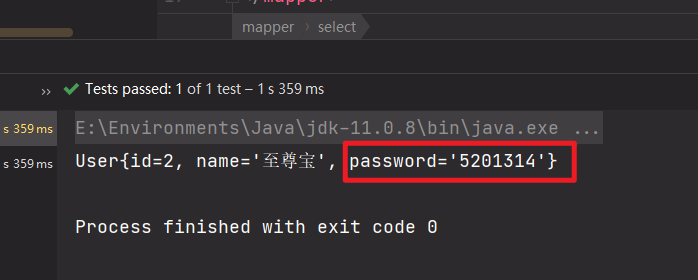
关于resultMap的一些说明:
resultMap元素是 MyBatis 中最重要最强大的元素。resultMap的设计思想是,对于简单的语句根本不需要配置显式的结果映射,而对于复杂一点的语句只需要描述它们的关系就行了。ResultMap最优秀的地方在于,虽然你已经对它相当了解了,但是根本就不需要显式地用到他们。
6、日志
6.1 日志工厂
日志顾名思义就是打印一些记录,在数据库中,如果出现了错误,一般很难排错,这时,日志就是最大的帮手!

- SLF4J
- LOG4J
- LOG4J2
- JDK_LOGGING
- COMMONS_LOGGING
- STDOUT_LOGGING
- NO_LOGGING
在Mybatis中使用哪种日志,具体的还要看我们怎么设置。
STDOUT_LOGGING标准日志输出:
在mybatis-config.xml这个核心配置文件中增加如下语句:
<settings><!-- 千万要注意xml的配置顺序,以及setting里面的名字的值,不能写错,--><setting name="logImpl" value="STDOUT_LOGGING"/></settings>

6.2 log4j
什么是Log4j?
- Log4j是Apache的一个开源项目,通过使用Log4j,我们可以控制日志信息输送的目的地是控制台、文件、GUI组件
- 我们也可以控制每一条日志的输出格式;
- 通过定义每一条日志信息的级别,我们能够更加细致地控制日志的生成过程。
- 通过一个配置文件来灵活地进行配置,而不需要修改应用的代码。
使用log4j的步骤:
1.导入依赖
<!-- https://mvnrepository.com/artifact/log4j/log4j --><dependency><groupId>log4j</groupId><artifactId>log4j</artifactId><version>1.2.17</version></dependency>
2.log4j.properties
#将等级为DEBUG的日志信息输出到console和file这两个目的地,console和file的定义在下面的代码log4j.rootLogger=DEBUG,console,file#控制台输出的相关设置log4j.appender.console = org.apache.log4j.ConsoleAppenderlog4j.appender.console.Target = System.outlog4j.appender.console.Threshold=DEBUGlog4j.appender.console.layout = org.apache.log4j.PatternLayoutlog4j.appender.console.layout.ConversionPattern=[%c]-%m%n#文件输出的相关设置log4j.appender.file = org.apache.log4j.RollingFileAppenderlog4j.appender.file.File=./log/kuang.loglog4j.appender.file.MaxFileSize=10mblog4j.appender.file.Threshold=DEBUGlog4j.appender.file.layout=org.apache.log4j.PatternLayoutlog4j.appender.file.layout.ConversionPattern=[%p][%d{yy-MM-dd}][%c]%m%n#日志输出级别log4j.logger.org.mybatis=DEBUGlog4j.logger.java.sql=DEBUGlog4j.logger.java.sql.Statement=DEBUGlog4j.logger.java.sql.ResultSet=DEBUGlog4j.logger.java.sql.PreparedStatement=DEBUG
3.在mybatis-config.xml中注册相关配置
<settings><setting name="logImpl" value="LOG4J"/></settings>
4.在要使用log4j的类中,导入包 org.apache.log4j.Logger
5.创建日志对象。
static Logger logger=Logger.getLogger("MyTest.class");
6.使用日志对象的方法(设置日志的级别)
public void TestLogger(){logger.info("进入了log4j的方法!");logger.debug("[debug]debug的log4j日志");logger.error("[error]这是一个error");}
运行测试:
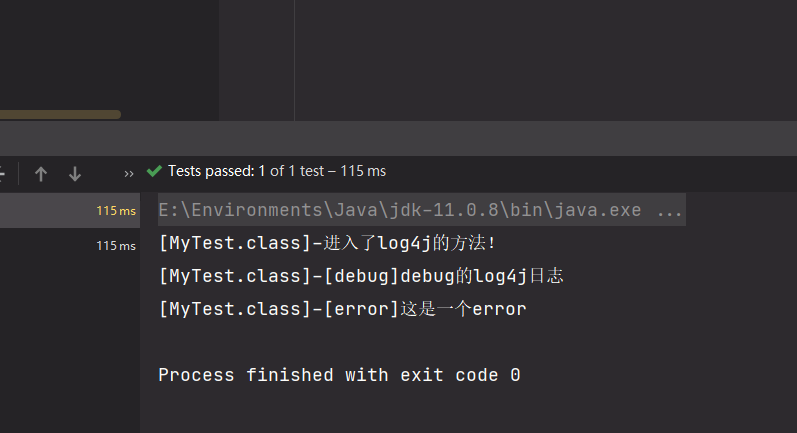
7、分页
7.1使用limit分页
知识回顾: mysql中:
select * from [table] limit startIndex,pageSize;#startIndex表示起始下标 表示从哪个开始;pageSize 表示一页显示多少条select * from user limit 3#只有一个参数表示显示多少条数据 [0,n]
使用mabatis 实现分页 (核心是sql的limit语句)
1.接口定义一个方法:
List<User> getLimitUser(Map<String,Integer> map);
2.配置Mapper
<select id="getLimitUser" parameterType="map" resultMap="UserMap" >select *from user limit #{startIndex} ,#{pageSize}</select>
3.测试
@Testpublic void TestGetLimitUser(){SqlSession sqlSession = MybatisUtil.getSqlSession();UserMapper mapper = sqlSession.getMapper(UserMapper.class);Map<String, Integer> map = new HashMap<>();map.put("startIndex",1);map.put("pageSize",3);List<User> limitUser = mapper.getLimitUser(map);for (User user : limitUser) {System.out.println(user);}sqlSession.close();}
运行结果:
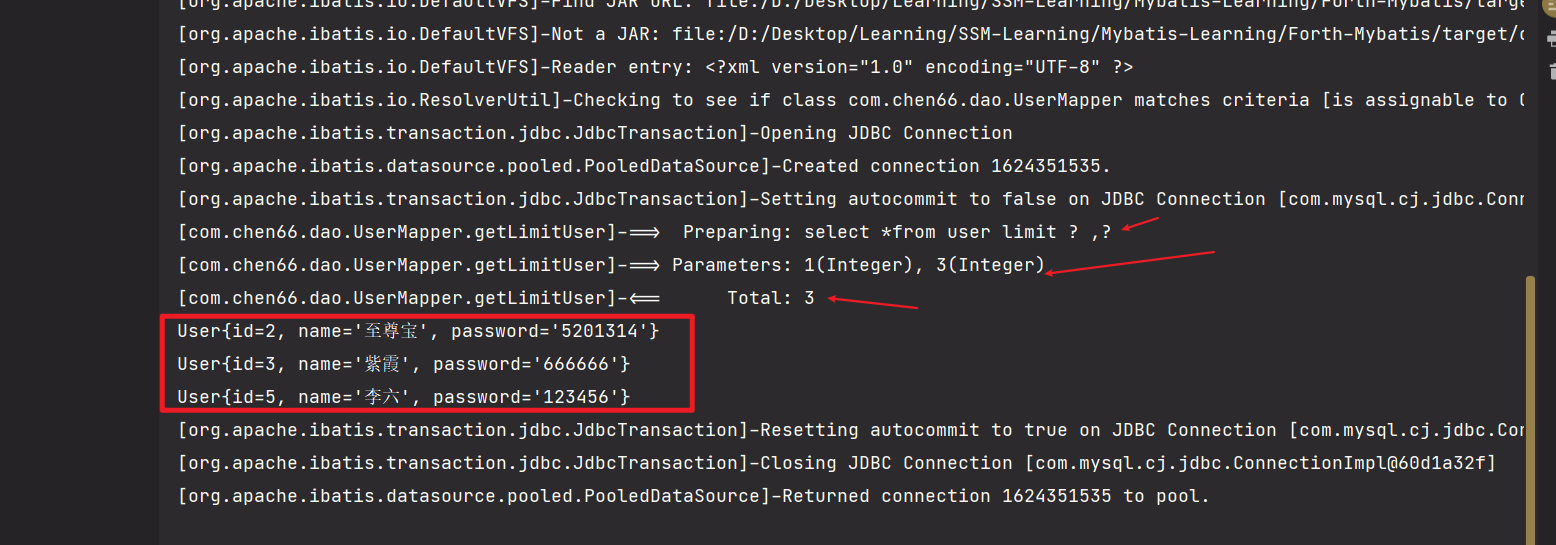
7.2RowBounds分页
使用java代码实现分页
1.编写接口:
//使用RowBands实现分页List<User> getRowBoundsUser();
2.编写Mapper
<select id="getRowBoundsUser" resultMap="UserMap">select * from user;</select>
3.测试:
@Testpublic void TestGetRowBoundsUser(){SqlSession sqlSession = MybatisUtil.getSqlSession();RowBounds rowBounds = new RowBounds(1,3);List<User> UserList = sqlSession.selectList("com.chen66.dao.UserMapper.getRowBoundsUser", null, rowBounds);for (User user : UserList) {System.out.println(user);}sqlSession.close();}
运行结果:
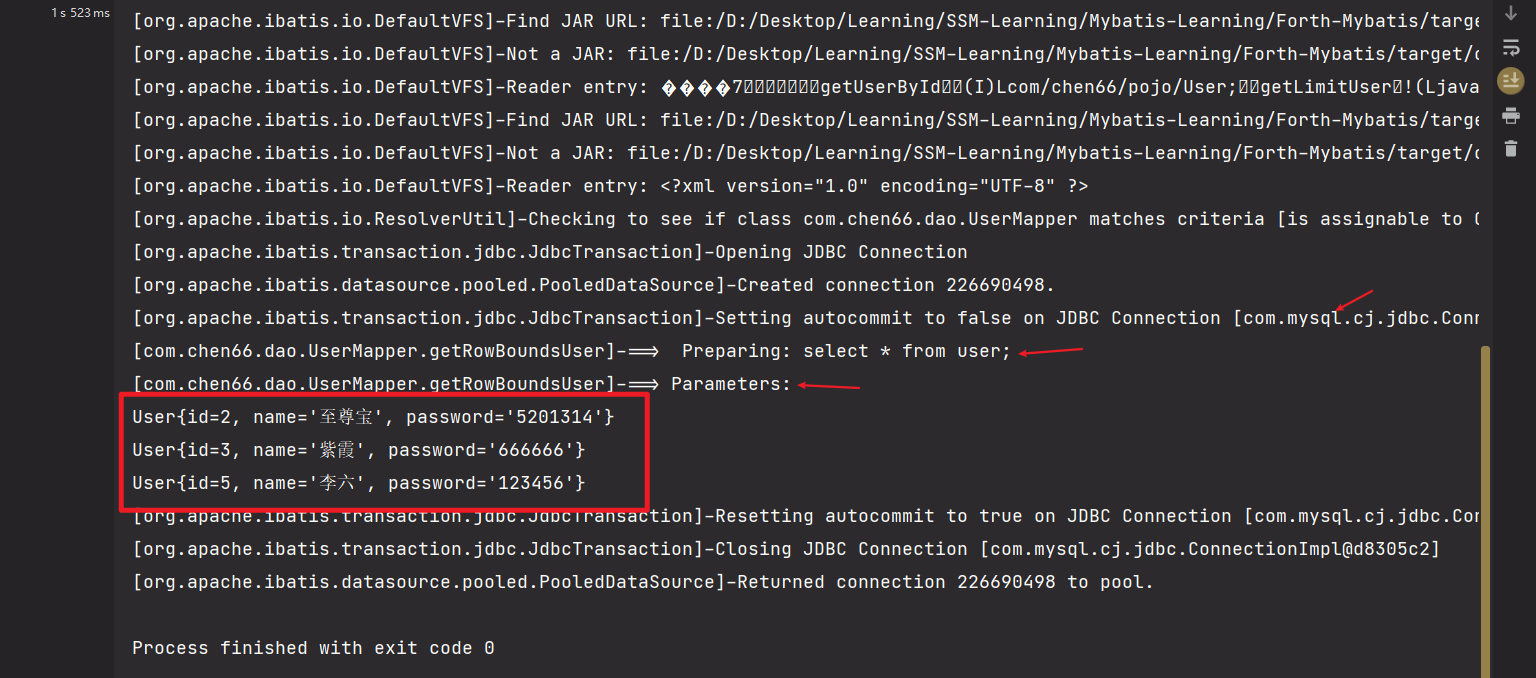
7.3分页插件
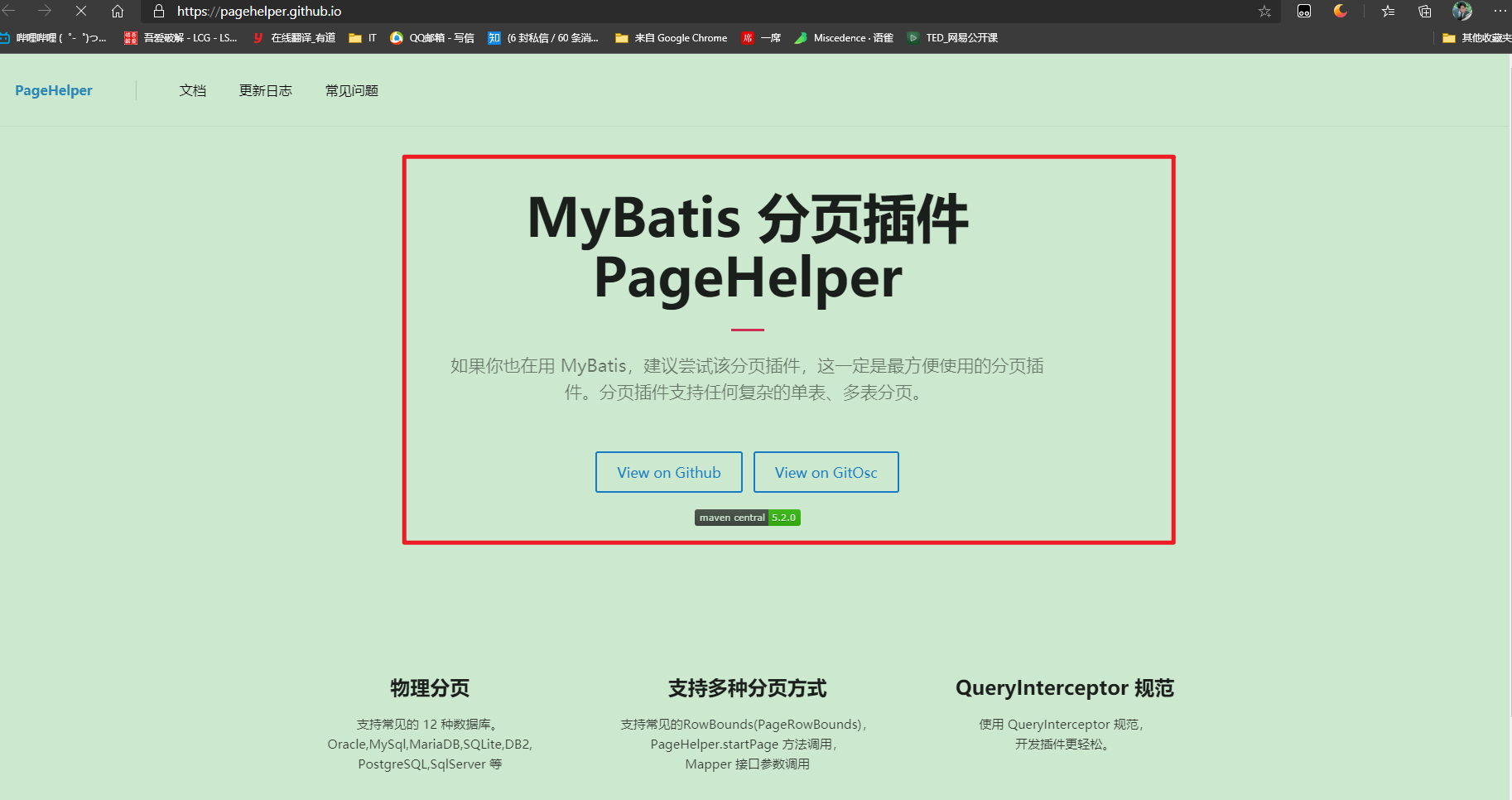
【了解】
8、使用注解开发
8.1、面向接口编程
- 大家之前都学过面向对象编程,也学习过接口,但在真正的开发中,很多时候我们会选择面向接口编程
- 根本原因 : 解耦 , 可拓展 , 提高复用 , 分层开发中 , 上层不用管具体的实现 , 大家都遵守共同的标准 , 使得开发变得容易 , 规范性更好
- 在一个面向对象的系统中,系统的各种功能是由许许多多的不同对象协作完成的。在这种情况下,各个对象内部是如何实现自己的,对系统设计人员来讲就不那么重要了;
- 而各个对象之间的协作关系则成为系统设计的关键。小到不同类之间的通信,大到各模块之间的交互,在系统设计之初都是要着重考虑的,这也是系统设计的主要工作内容。面向接口编程就是指按照这种思想来编程。
关于接口的理解
- 接口从更深层次的理解,应是定义(规范,约束)与实现(名实分离的原则)的分离。
- 接口的本身反映了系统设计人员对系统的抽象理解。
- 接口应有两类:
- 第一类是对一个个体的抽象,它可对应为一个抽象体(abstract class);
- 第二类是对一个个体某一方面的抽象,即形成一个抽象面(interface);
- 一个体有可能有多个抽象面。抽象体与抽象面是有区别的。
三个面向区别
- 面向对象是指,我们考虑问题时,以对象为单位,考虑它的属性及方法 .
- 面向过程是指,我们考虑问题时,以一个具体的流程(事务过程)为单位,考虑它的实现 .
- 接口设计与非接口设计是针对复用技术而言的,与面向对象(过程)不是一个问题.更多的体现就是对系统整体的架构
8.2、使用注解开发
1.接口:
//通过id查询对应用户@Select("select *from user where id=#{uid}")User getUserById(@Param("uid") int id);
2.在配置文件中注册注解类
<mappers><mapper class="com.chen66.dao.UserMapper"/></mappers>
3.测试:
@Testpublic void TestSelectById(){SqlSession sqlSession = MybatisUtil.getSqlSession();UserMapper mapper = sqlSession.getMapper(UserMapper.class);User userById = mapper.getUserById(2);System.out.println(userById);sqlSession.close();}
8.3 注解实现CRUD
1.接口:
//通过id查询对应用户@Select("select *from user where id=#{uid}")User getUserById(@Param("uid") int id);//增@Insert("insert into user(`id`,`name`,`pwd`) values(#{uid},#{uname},#{upwd})")int AddUser(@Param("uid")int id,@Param("uname")String name,@Param("upwd")String pwd);//删@Delete("delete from user where id=#{uid}")int DeleteUser(@Param("uid") int id);//改@Update("update user set `name`=#{uname},pwd=#{upwd} where id=#{uid}")int UpdateUser(@Param("uid")int id,@Param("uname") String name,@Param("upwd") String pwd);
2.注册mapper【重要】
<mappers><mapper class="com.chen66.dao.UserMapper"/></mappers>
关于@Param() 注解
- 基本类型的参数或者String类型,需要加上
- 引用类型不需要加
- 如果只有一个基本类型的话,可以忽略,但是建议大家都加上!
- 我们在SQL中引用的就是我们这里的 @Param() 中设定的属性名!
#{} ${} 区别
{} 可以更大程度上防止sql注入
${} 则不可以防止sql注入
8.4 Mybatis详细执行流程
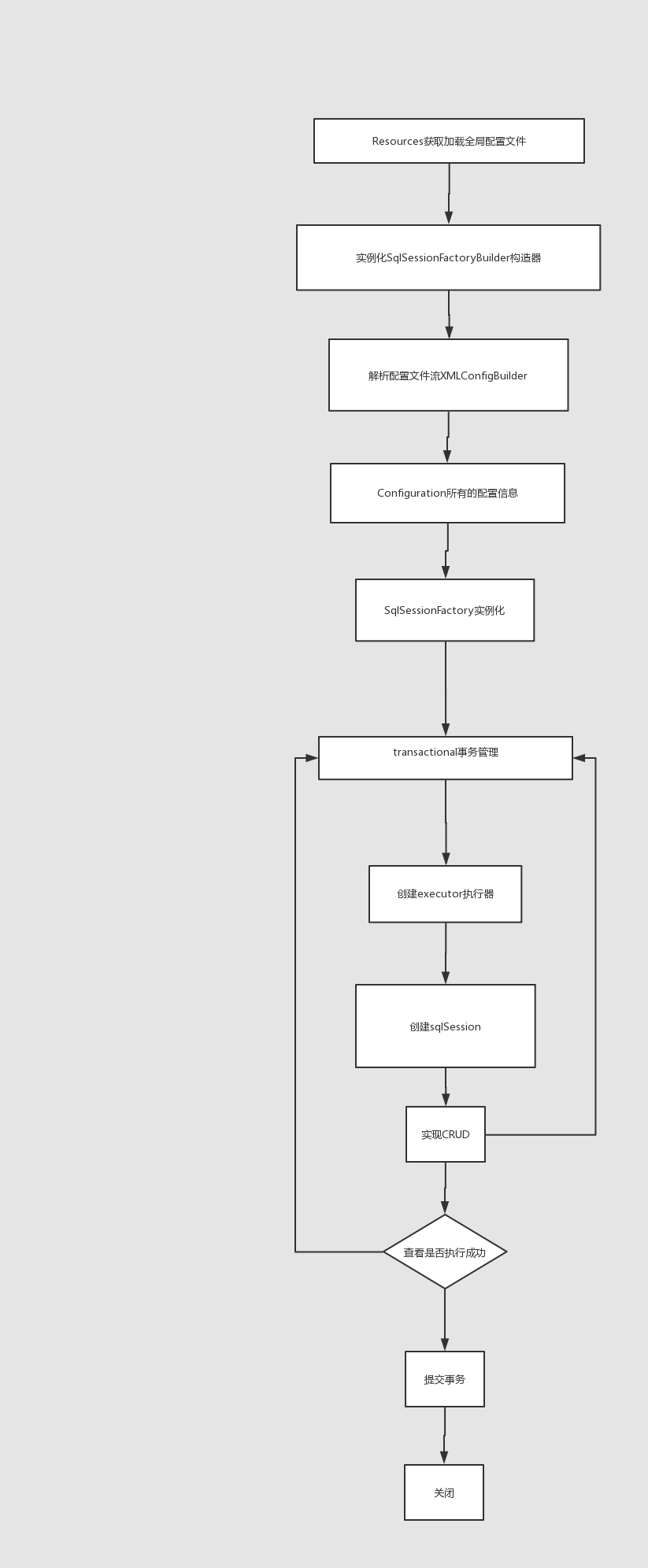
9、Lombok
官网解释:
Project Lombok is a java library that automatically plugs into your editor and build tools, spicing up your java. Never write another getter or equals method again, with one annotation your class has a fully featured builder, Automate your logging variables, and much more.
其实就是一款插件:用来偷懒的。
省去写setter、setter、euqals、hashcode等等重复造轮子的方法。
使用步骤:
1.IDEA中安装lombok的插件
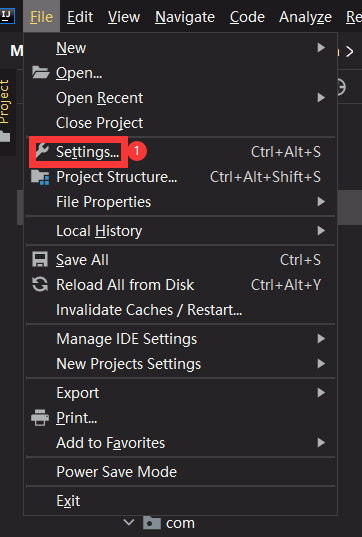

2.添加maven依赖
<!-- https://mvnrepository.com/artifact/org.projectlombok/lombok --><dependency><groupId>org.projectlombok</groupId><artifactId>lombok</artifactId><version>1.18.16</version><scope>provided</scope></dependency>
3.测试使用

只需添加注解,即可实现这些方法。
说明: @Data:无参构造,get、set、tostring、hashcode,equals @AllArgsConstructor @NoArgsConstructor @EqualsAndHashCode @ToString @Getter
10、多对一
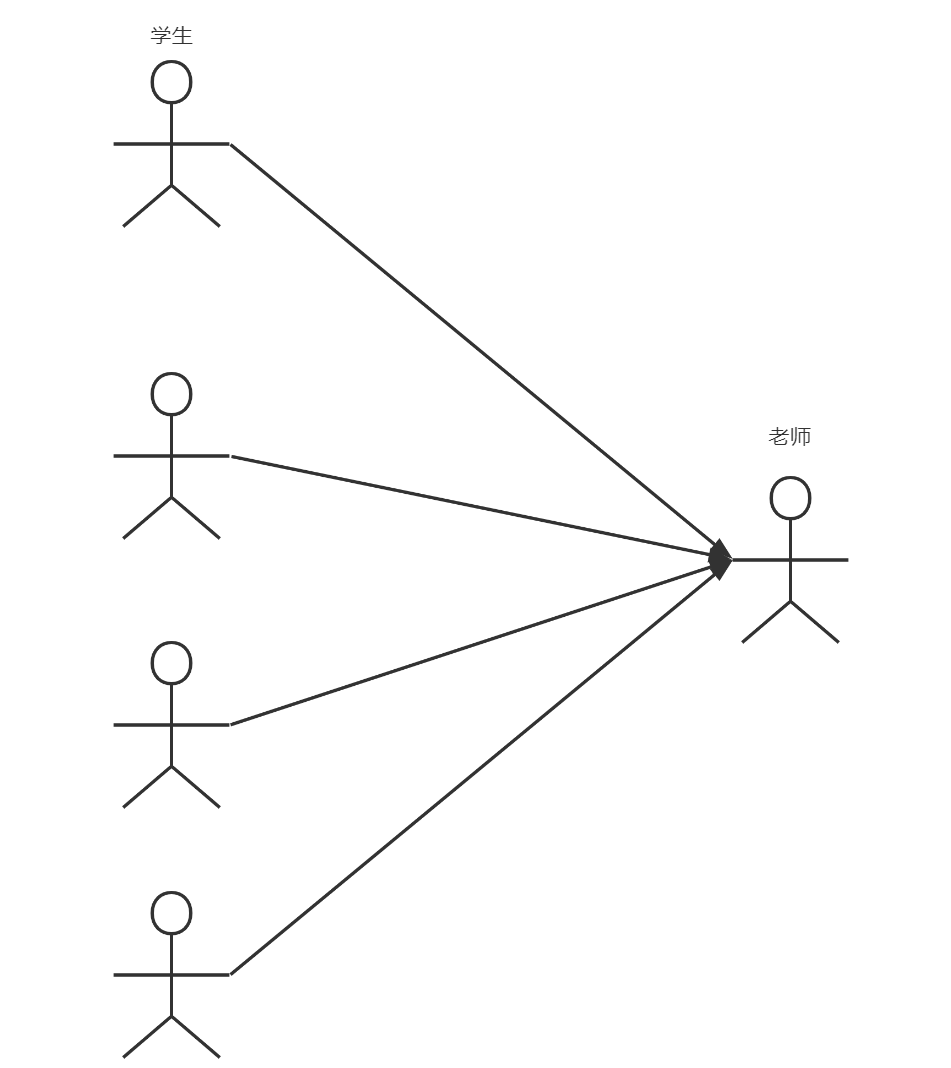
- 多个学生,对应一个老师
- 对于学生这边而言, 关联 .. 多个学生,关联一个老师 【多对一】
- 对于老师而言, 集合 , 一个老师,有很多学生 【一对多】
准备工作:
1、数据库准备:
SQL语句:
CREATE TABLE `teacher` (`id` INT(10) NOT NULL,`name` VARCHAR(30) DEFAULT NULL,PRIMARY KEY (`id`)) ENGINE=INNODB DEFAULT CHARSET=utf8INSERT INTO teacher(`id`, `name`) VALUES (1, '秦老师');CREATE TABLE `student` (`id` INT(10) NOT NULL,`name` VARCHAR(30) DEFAULT NULL,`tid` INT(10) DEFAULT NULL,PRIMARY KEY (`id`),KEY `fktid` (`tid`),CONSTRAINT `fktid` FOREIGN KEY (`tid`) REFERENCES `teacher` (`id`)) ENGINE=INNODB DEFAULT CHARSET=utf8INSERT INTO `student` (`id`, `name`, `tid`) VALUES ('1', '小明', '1');INSERT INTO `student` (`id`, `name`, `tid`) VALUES ('2', '小红', '1');INSERT INTO `student` (`id`, `name`, `tid`) VALUES ('3', '小张', '1');INSERT INTO `student` (`id`, `name`, `tid`) VALUES ('4', '小李', '1');INSERT INTO `student` (`id`, `name`, `tid`) VALUES ('5', '小王', '1');
表关系:

2.开启Lombok支持
3.新建Students和Teachers实体类
public interface StudentMapper {@Select("select *from student")List<Student> GetStudents();}
public interface TeacherMapper {@Select("select *from teacher")List<Teacher> GetTeacher();}
4.注册mapper
<mappers><mapper class="com.chen66.dao.StudentMapper"/><mapper class="com.chen66.dao.TeacherMapper"/></mappers>
5.测试
简单多对一(两张表测试)
1.接口:
public interface StudentMapper {List<Student> getStudentList();List<Student> getStudentList2();}
2.Mapper
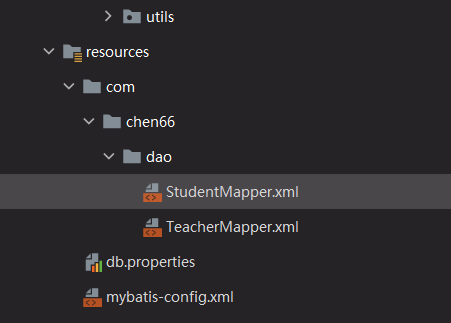
按照查询嵌套处理:
<!-- 按照结果嵌套处理--><select id="getStudentList" resultMap="StudentTeacher">select s.id sid,s.name sname,t.name tnamefrom student s,teacher twhere s.tid=t.id;</select><resultMap id="StudentTeacher" type="Student"><result property="id" column="sid" /><result property="name" column="sname"/><association property="teacher" javaType="Teacher"><result property="name" column="tname"/></association></resultMap>
按照查询嵌套处理:
<!-- 按照查询嵌套处理--><select id="getStudentList2" resultMap="StudentTeacher2">select *from student</select><resultMap id="StudentTeacher2" type="Student"><result property="id" column="id"/><result property="name" column="name"/><!--复杂的属性,我们需要单独处理 对象: association 集合: collection --><association property="teacher" column="tid" javaType="Teacher" select="getTeacher"/></resultMap><select id="getTeacher" resultType="Teacher">select *from teacher where id=#{id}</select>
注意别忘了匹配namespace
3.注册mapper
<mappers><mapper class="com.chen66.dao.StudentMapper"/><mapper class="com.chen66.dao.TeacherMapper"/></mappers>
4.测试
@Testpublic void Test(){SqlSession sqlSession = MybatisUtil.getSqlSession();StudentMapper mapper = sqlSession.getMapper(StudentMapper.class);// 按照结果嵌套List<Student> students = mapper.getStudentList();for (Student student : students) {System.out.println(student);}System.out.println("==============================");// 按照查询嵌套List<Student> students2 = mapper.getStudentList2();for (Student student : students2) {System.out.println(students2);}sqlSession.close();}
测试结果:
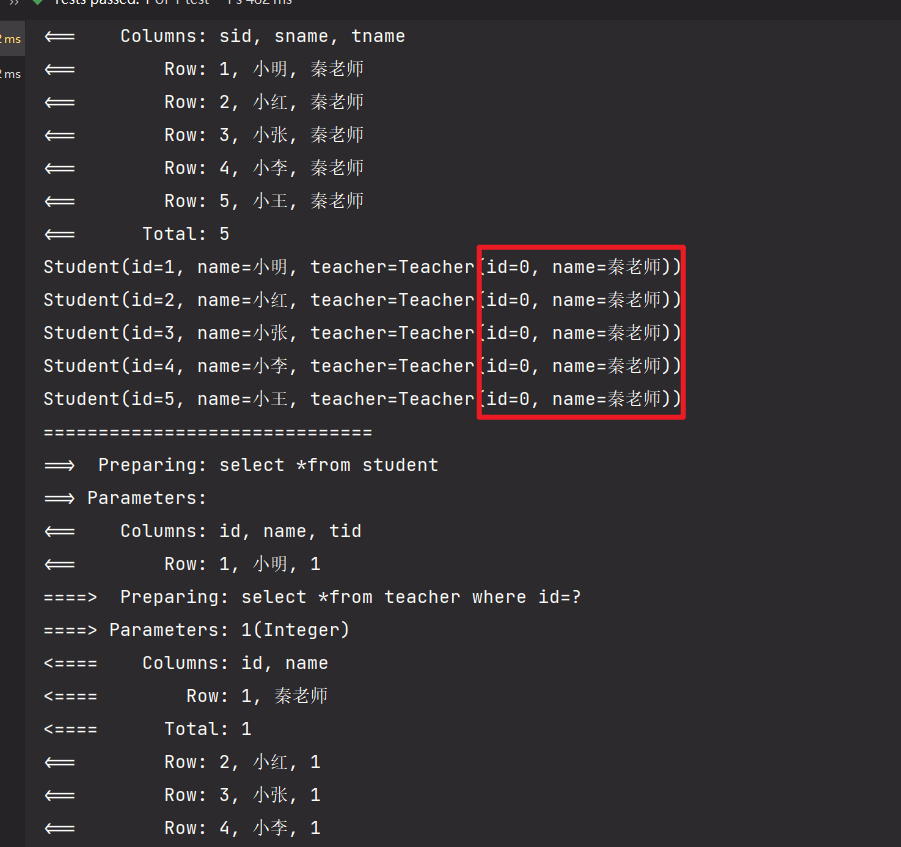
回顾Mysql 多对一查询方式:
- 子查询
- 联表查询
11、一对多
上述的例子中,学生对老师是多对一,反过来,一位老师名下有多个学生,就是一对多。
简单实现:
接口:
public interface TeacherMapper {Teacher getTeacherById(int tid);}
public interface StudentMapper {List<Student> getStudent();}
pojo:
@Datapublic class Teacher {private int id;private String name;//一个老师拥有多个学生private List<Student> students;}
@Datapublic class Student {private int id;private String name;private int tid;}
Mapper:
1.按结构嵌套处理
<mapper namespace="com.chen66.dao.TeacherMapper"><select id="getTeacherById" resultMap="TeacherStudent" >select t.id tid,t.name tname,s.id sid,s.name snamefrom student s,teacher twhere t.id=s.tid and t.id=#{tid}</select><resultMap id="TeacherStudent" type="Teacher"><result property="id" column="id"/><result property="name" column="tname"/><!--复杂的属性,我们需要单独处理 对象: association 集合: collectionjavaType="" 指定属性的类型!集合中的泛型信息,我们使用ofType获取--><collection property="students" ofType="Student"><result property="id" column="sid"/><result property="name" column="sname"/><result property="tid" column="tid"/></collection></resultMap></mapper>
2.按查询嵌套处理
<select id="getTeacherById" resultMap="getStudentsTeacher">select *from teacherwhere id=${tid};</select><resultMap id="getStudentsTeacher" type="Teacher"><collection property="students" javaType="arrayList" ofType="Student" select="getStudents" column="id"/></resultMap><select id="getStudents" resultType="Student">select *from student where id=#{id}</select>
测试:
@Testpublic void Test(){SqlSession sqlSession = MybatisUtil.getSqlSession();TeacherMapper mapper = sqlSession.getMapper(TeacherMapper.class);Teacher teacherByid = mapper.getTeacherById(1);System.out.println(teacherByid);sqlSession.close();}
结果:
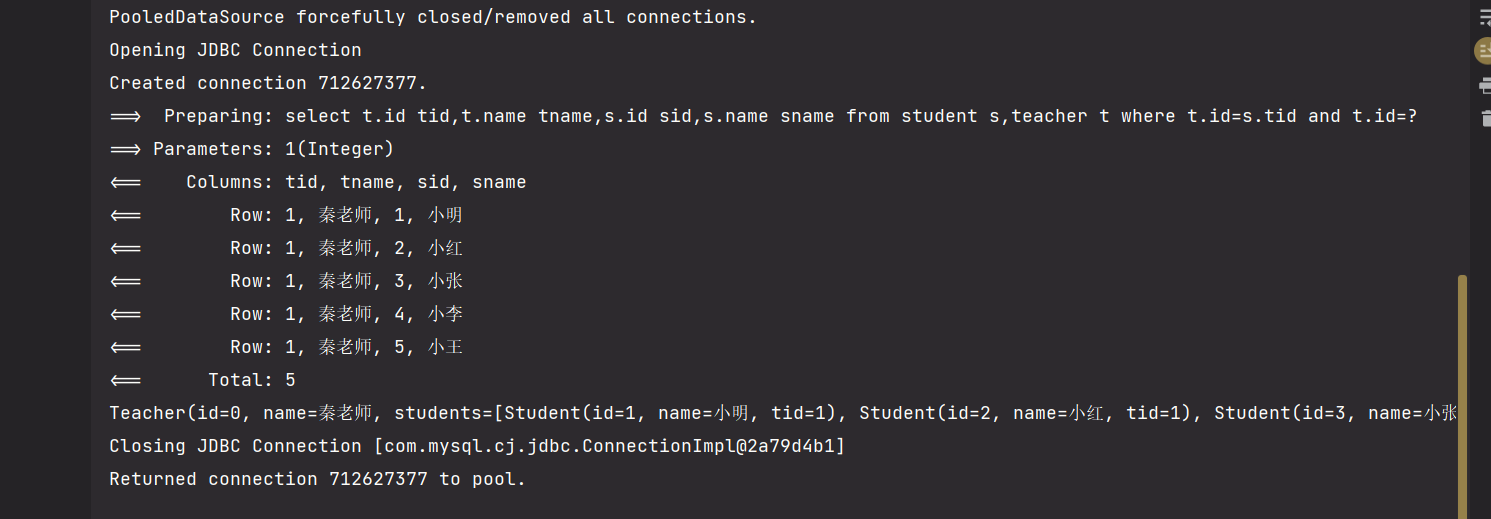
小结
- 关联 - association 【多对一】
- 集合 - collection 【一对多】
- javaType & ofType
- JavaType 用来指定实体类中属性的类型
- ofType 用来指定映射到List或者集合中的 pojo类型,泛型中的约束类型!
注意点:
- 保证SQL的可读性,尽量保证通俗易懂
- 注意一对多和多对一中,属性名和字段的问题!
- 如果问题不好排查错误,可以使用日志 , 建议使用 Log4j
慢SQL 1s 1000s
面试高频
- Mysql引擎
- InnoDB底层原理
- 索引
- 索引优化!
12、动态SQL
动态SQL是什么?
是指可以根据内容的不同动态生成不同的SQL语句
动态 SQL 是 MyBatis 的强大特性之一。如果你使用过 JDBC 或其它类似的框架,你应该能理解根据不同条件拼接 SQL 语句有多痛苦,例如拼接时要确保不能忘记添加必要的空格,还要注意去掉列表最后一个列名的逗号。利用动态 SQL,可以彻底摆脱这种痛苦。
如果你之前用过 JSTL 或任何基于类 XML 语言的文本处理器,你对动态 SQL 元素可能会感觉似曾相识。在 MyBatis 之前的版本中,需要花时间了解大量的元素。借助功能强大的基于 OGNL 的表达式,MyBatis 3 替换了之前的大部分元素,大大精简了元素种类,现在要学习的元素种类比原来的一半还要少。
- if
- choose (when, otherwise)
- trim (where, set)
- foreach
工程准备
数据库创建
CREATE TABLE `blog` (`id` VARCHAR(50) NOT NULL COMMENT '博客id',`title` VARCHAR(100) NOT NULL COMMENT '博客标题',`author` VARCHAR(30) NOT NULL COMMENT '博客作者',`create_time` DATETIME NOT NULL COMMENT '创建时间',`views` INT(30) NOT NULL COMMENT '浏览量') ENGINE=INNODB DEFAULT CHARSET=utf8
模块创建
- 导包
编写配置文件以及工具类
- UUID生成工具类 ```java @SuppressWarnings(“all”)//抑制警告 public class UidUtils { private static String getID(){ return UUID.randomUUID().toString().replaceAll(“-“,””);//将随机生成的数的 - 分隔符去掉 }
//测试
@Test public void Test(){ //bcca81da173a47ffa3ee647fba9f3206 System.out.println(getID()); } } ```
编写pojo类
@Datapublic class Blog {private String id;private String title;private String author;private Date createTime;private int views;}
编写pojo类对应的接口以及Mapper配置文件
接口:
int addBlog(Blog blog);
Mapper
<mapper namespace="com.chen66.dao.BlogMapper"><insert id="addBlog" parameterType="Blog">insert into blog (id, title, author, create_time, views)values (#{id}, #{title}, #{author}, #{createTime}, #{views});</insert></mapper>
记得在Mybatis-config.xml中配置开启自动驼峰命名映射
<!-- 是否开启驼峰命名自动映射,--><!-- 即从经典数据库列名 A_COLUMN 映射到经典 Java 属性名 aColumn。--><setting name="mapUnderscoreToCamelCase" value="true"/>
IF
用法测试
接口:
List<Blog> getBlogsIF(Map<String,Object> map);
Mapper
<select id="getBlogsIF" parameterType="map" resultType="Blog">select *from blog where 1=1<if test="title!=null">and title=#{title}</if><if test="author!=null">and author=#{author}</if></select>
测试:
@Testpublic void getBlogsIF(){SqlSession sqlSession = MybatisUtil.getSqlSession();BlogMapper mapper = sqlSession.getMapper(BlogMapper.class);HashMap<String, Object> hashMap = new HashMap<>();hashMap.put("title","java");hashMap.put("author","狂神说");List<Blog> blogsIF = mapper.getBlogsIF(hashMap);for (Blog blog : blogsIF) {System.out.println(blog);}sqlSession.close();}
trim(where和set)
where
上述例子中,之所以加上where 1=1是为了去除第一个where条件,从第二条件开始 前面都要加入and 才可以保证sql语句查询结果正确
为了说明where的作用,把上述1=1去掉,再次运行,会报错:

因为第一个条件是不需要加and语句的
这时,<where>标签就发挥作用了!
where 元素只会在子元素返回任何内容的情况下才插入 “WHERE” 子句。而且,若子句的开头为 “AND” 或 “OR”,where 元素也会将它们去除。
加入where标签后
首先要去掉自己加入的where语句,由上述官网对where标签的作用的解释中就说到只会在有返回内容的情况下自动插入where语句。
<select id="getBlogsIF" parameterType="map" resultType="Blog">select *from blog where<where><if test="title!=null">and title=#{title}</if><if test="author!=null">and author=#{author}</if></where></select>

会发现第一个条件的and 语句被自动去除了!这就是where标签的作用
set
同样,在插入或更新操作时,也会遇到上述类似的问题。
因此,在实现动态插入更新操作时,Set标签就能实现
set 元素可以用于动态包含需要更新的列,忽略其它不更新的列。 set 元素会动态地在行首插入 SET 关键字,并会删掉额外的逗号(这些逗号是在使用条件语句给列赋值时引入的)。
如:
//更新博客int UpdateBlog(Map<String,Object> map);
<update id="UpdateBlog" parameterType="map">update blog<set><if test="title">title=#{title},</if><if test="author">author=#{author},</if><if test="createTime">create_time=#{createTime},</if><if test="views">views=#{views},</if></set>where id=#{id}</update>
@Testpublic void UpdateBlog(){SqlSession sqlSession = MybatisUtil.getSqlSession();BlogMapper mapper = sqlSession.getMapper(BlogMapper.class);Map<String,Object> map = new HashMap<>();map.put("id","1b6f95d5460b4af5aaf375a0b988fe80");// map.put("title","java2");map.put("createTime",new Date());mapper.UpdateBlog(map);sqlSession.close();}

查看数据库表:

OK
使用了Set标签,当更新第三个元素时,set语句有标签自动在首行插入,多余的逗号也会被删除。
choose (when, otherwise)
有时候,我们不想使用所有的条件,而只是想从多个条件中选择一个使用。MyBatis 提供了 choose 元素,它有点像 Java 中的 switch 语句。
比如:
List<Blog> getBlogsChoose(Map<String,Object> map);
<select id="getBlogsChoose" parameterType="map" resultType="Blog">select *from blog<where><choose><when test="title!=null">and title=#{title}</when><when test="author!=null">and author=#{author}</when><when test="createTime!=null">and create_time=#{createTime}</when><otherwise>and views=#{views}</otherwise></choose></where></select>
@Testpublic void getBlogsChooseTest(){SqlSession sqlSession = MybatisUtil.getSqlSession();BlogMapper mapper = sqlSession.getMapper(BlogMapper.class);Map<String, Object> map = new HashMap<>();map.put("author","狂神说");map.put("views","9999");List<Blog> blogsChoose = mapper.getBlogsChoose(map);for (Blog blog : blogsChoose) {System.out.println(blog);}sqlSession.close();}
结果:
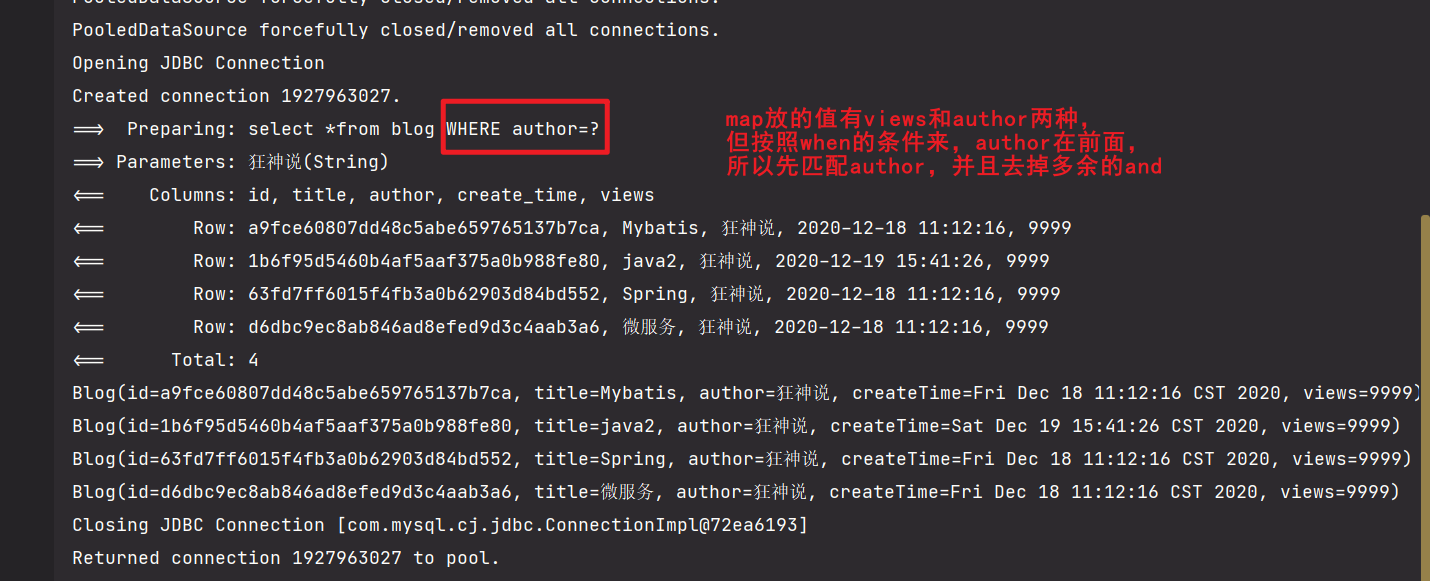
假如这时候map为空:

由于设置views为默认选择,所以为空时,view无值,所以查询结果也为空。如果去掉otherwise,则会查询所有

SQL片段
有时候,很多代码都是重复的,这时候,我们可以把它们抽取出来,方便复用,减少代码的冗余。
1.使用SQL标签抽取公共的部分
<!-- SQL片段--><sql id="sql-title-author"><if test="title!=null">and title=#{title}</if><if test="author!=null">and author=#{author}</if></sql>
2.在需要使用的地方使用Include标签引用即可
<select id="getBlogsIF" parameterType="map" resultType="Blog">select *from blog<where><include refid="sql-title-author"></include></where></select>
注意事项:
- 最好基于单表来定义SQL片段!
- 不要存在where标签
foreach
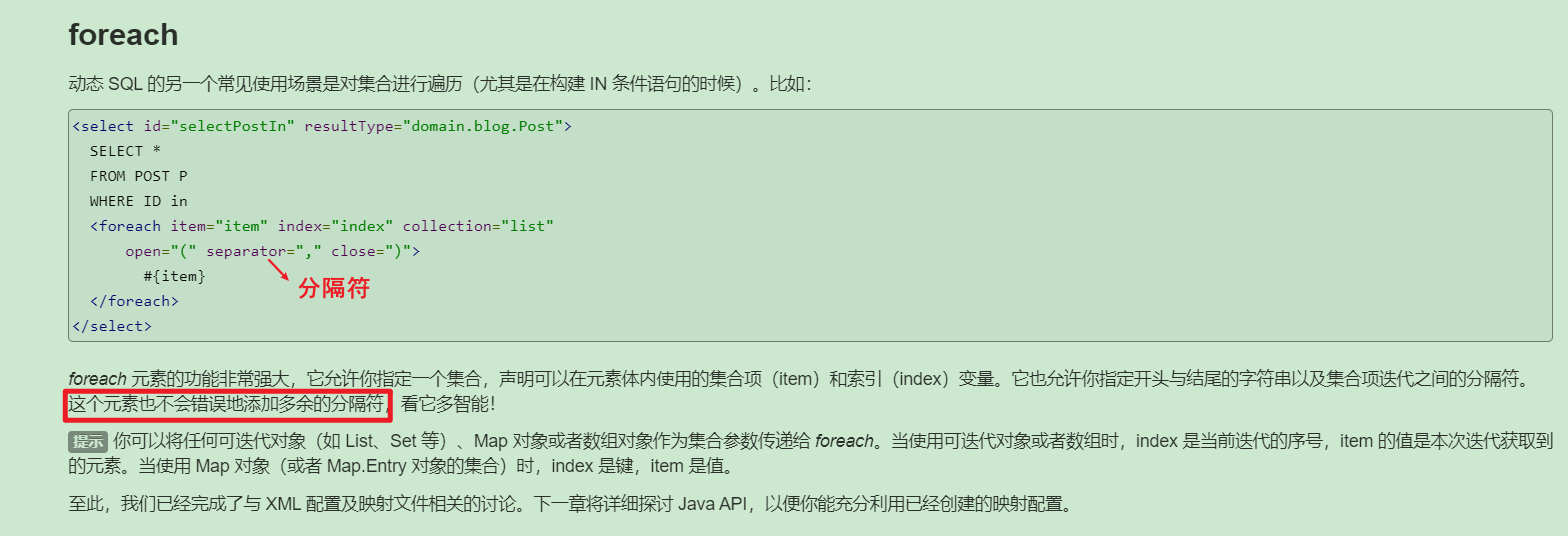
演示示例:
1.接口:
//foreach查询遍历结果List<Blog> getBlogsForeach(Map<String,Object> map);
Mapper:
- 先写好sql语句进行批量查询
select * from blog where (id=1 or id=2 or id=4)
查询结果:

- 然后想办法拼接:
分析:- 用where标签进行“保险定性”(如果集合的值为空,还能确保里面的and或者where语句被where标签去掉,非常智能嗷)
- 开始为 (
- 分隔符为 or
- 结束为 )
- 集合名称就设为ids
- 集合中每个元素设为id
- 将值从id中取出
<!-- Foreach动态查询--><select id="getBlogsForeach" parameterType="map" resultType="Blog">select *from blog<where><foreach collection="ids" open="and (" close=")" item="id" separator="or">id=#{id}</foreach></where></select>
测试:
1.lids为空:
@Testpublic void getBlogsForeach(){SqlSession sqlSession = MybatisUtil.getSqlSession();BlogMapper mapper = sqlSession.getMapper(BlogMapper.class);HashMap<String, Object> hashMap = new HashMap<>();ArrayList<Integer> ids = new ArrayList<>();hashMap.put("ids",ids);List<Blog> blogsForeach = mapper.getBlogsForeach(hashMap);for (Blog blog : blogsForeach) {System.out.println(blog);}sqlSession.close();}
结果:
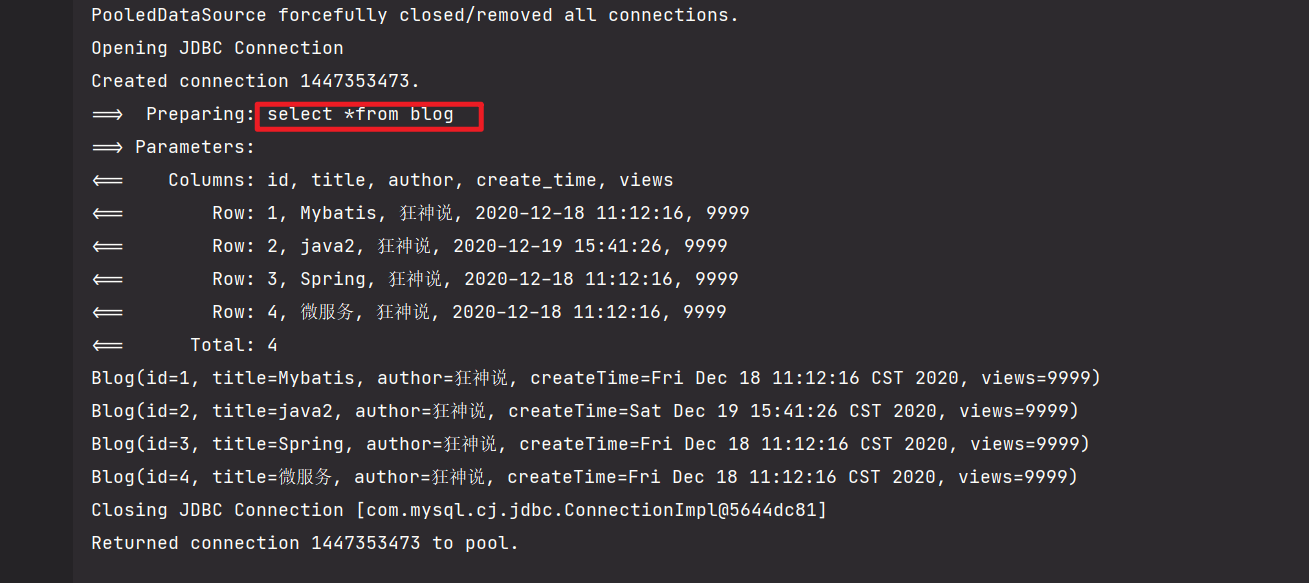
2.在ids集合中,添加元素:
ids.add(1);ids.add(2);ids.add(4);
结果:
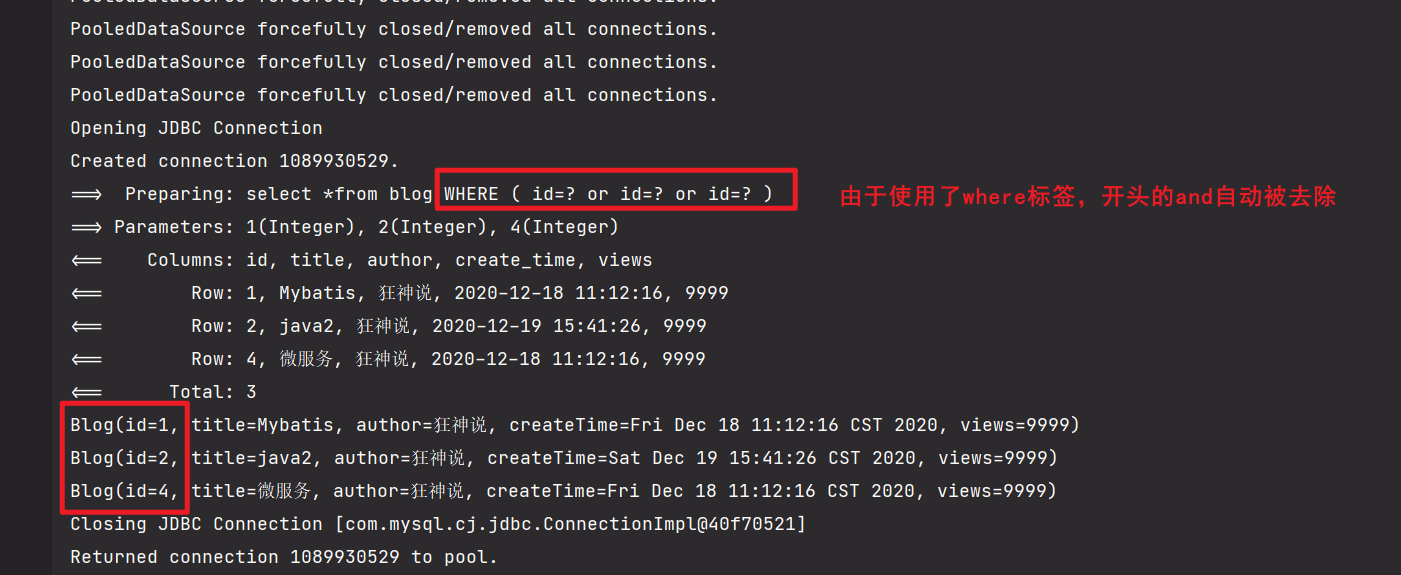
所谓的动态SQL,本质还是SQL语句 , 只是我们可以在SQL层面,去执行一个逻辑代码
13、缓存 (了解)[搬砖]
13.1、简介
查询 : 连接数据库 ,耗资源!一次查询的结果,给他暂存在一个可以直接取到的地方!--> 内存 : 缓存我们再次查询相同数据的时候,直接走缓存,就不用走数据库了
- 什么是缓存 [ Cache ]?
- 存在内存中的临时数据。
- 将用户经常查询的数据放在缓存(内存)中,用户去查询数据就不用从磁盘上(关系型数据库数据文件)查询,从缓存中查询,从而提高查询效率,解决了高并发系统的性能问题。
- 为什么使用缓存?
- 减少和数据库的交互次数,减少系统开销,提高系统效率。
- 什么样的数据能使用缓存?
- 经常查询并且不经常改变的数据。【可以使用缓存】
13.2、Mybatis缓存
- MyBatis包含一个非常强大的查询缓存特性,它可以非常方便地定制和配置缓存。缓存可以极大的提升查询效率。
- MyBatis系统中默认定义了两级缓存:一级缓存和二级缓存
- 默认情况下,只有一级缓存开启。(SqlSession级别的缓存,也称为本地缓存)
- 二级缓存需要手动开启和配置,他是基于namespace级别的缓存。
- 为了提高扩展性,MyBatis定义了缓存接口Cache。我们可以通过实现Cache接口来自定义二级缓存
13.3、一级缓存
- 一级缓存也叫本地缓存: SqlSession
- 与数据库同一次会话期间查询到的数据会放在本地缓存中。
- 以后如果需要获取相同的数据,直接从缓存中拿,没必须再去查询数据库;
测试步骤:
- 开启日志!
- 测试在一个Sesion中查询两次相同记录
- 查看日志输出
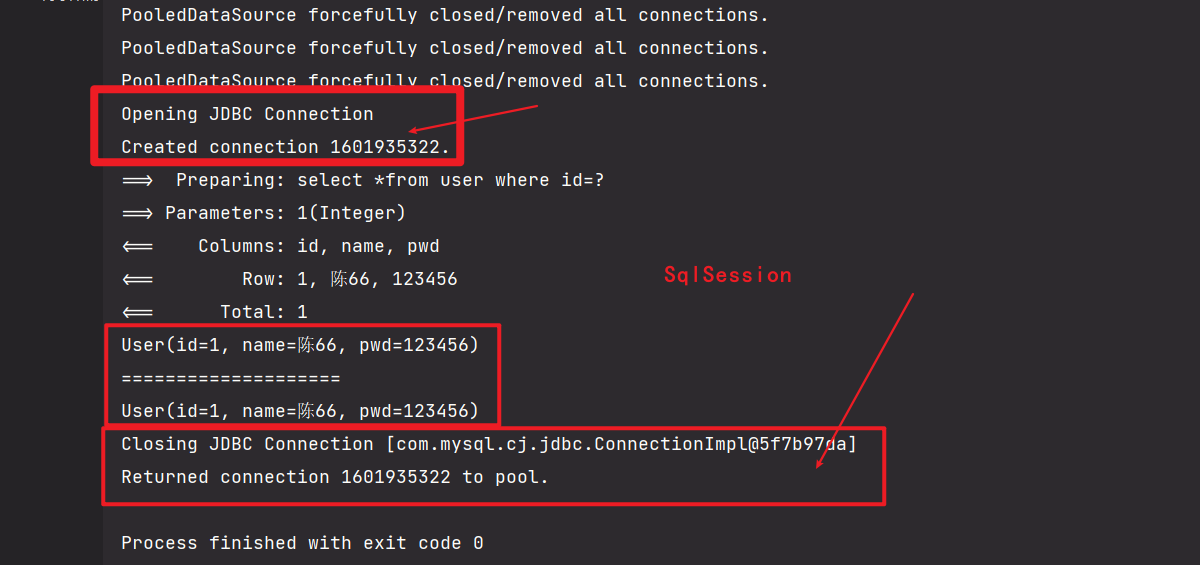
缓存失效的情况:
- 查询不同的东西
- 增删改操作,可能会改变原来的数据,所以必定会刷新缓存!
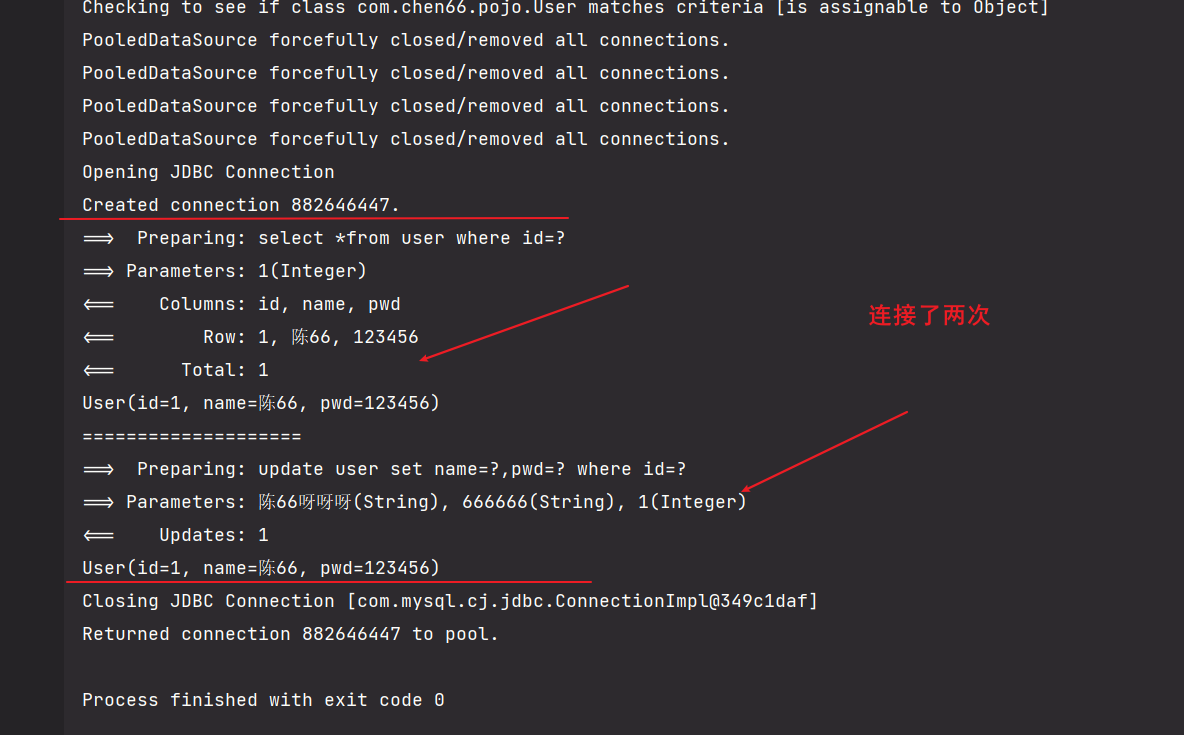
- 查询不同的Mapper.xml
- 手动清理缓存!
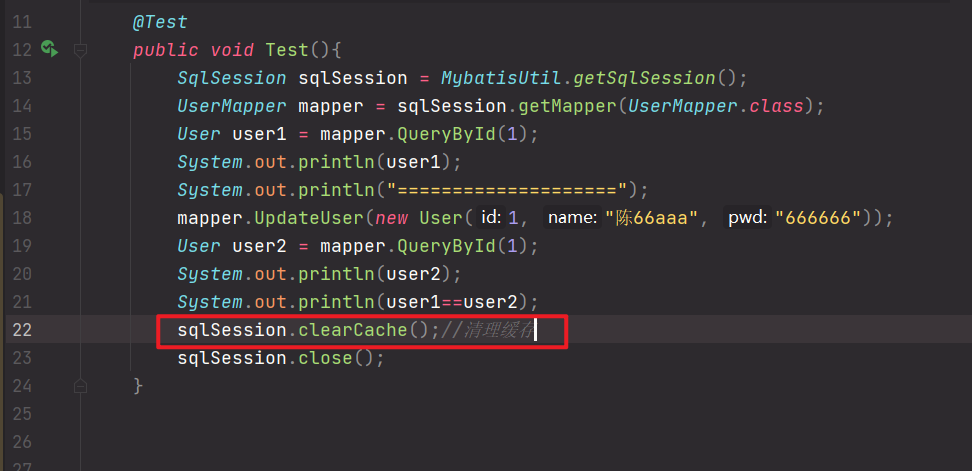
小结:一级缓存默认是开启的,只在一次SqlSession中有效,也就是拿到连接到关闭连接这个区间段!
一级缓存就是一个Map。
13.4、二级缓存
- 二级缓存也叫全局缓存,一级缓存作用域太低了,所以诞生了二级缓存
- 基于namespace级别的缓存,一个名称空间,对应一个二级缓存;
- 工作机制
- 一个会话查询一条数据,这个数据就会被放在当前会话的一级缓存中;
- 如果当前会话关闭了,这个会话对应的一级缓存就没了;但是我们想要的是,会话关闭了,一级缓存中的数据被保存到二级缓存中;
- 新的会话查询信息,就可以从二级缓存中获取内容;
- 不同的mapper查出的数据会放在自己对应的缓存(map)中;
步骤:
开启全局缓存
<!--显示的开启全局缓存--><setting name="cacheEnabled" value="true"/>
在要使用二级缓存的Mapper中开启
<!--在当前Mapper.xml中使用二级缓存--><cache/>
也可以自定义参数
<!--在当前Mapper.xml中使用二级缓存--><cache eviction="FIFO"flushInterval="60000"size="512"readOnly="true"/>
测试
- 问题:我们需要将实体类序列化!否则就会报错!
Caused by: java.io.NotSerializableException: com.kuang.pojo.User
- 问题:我们需要将实体类序列化!否则就会报错!
小结:
- 只要开启了二级缓存,在同一个Mapper下就有效
- 所有的数据都会先放在一级缓存中;
- 只有当会话提交,或者关闭的时候,才会提交到二级缓冲中!
13.5、缓存原理

13.6、自定义缓存-ehcache
Ehcache是一种广泛使用的开源Java分布式缓存。主要面向通用缓存
要在程序中使用ehcache,先要导包!
<!-- https://mvnrepository.com/artifact/org.mybatis.caches/mybatis-ehcache --><dependency><groupId>org.mybatis.caches</groupId><artifactId>mybatis-ehcache</artifactId><version>1.1.0</version></dependency>
在mapper中指定使用我们的ehcache缓存实现!
<!--在当前Mapper.xml中使用二级缓存--><cache type="org.mybatis.caches.ehcache.EhcacheCache"/>
ehcache.xml
<?xml version="1.0" encoding="UTF-8"?><ehcache xmlns:xsi="http://www.w3.org/2001/XMLSchema-instance"xsi:noNamespaceSchemaLocation="http://ehcache.org/ehcache.xsd"updateCheck="false"><!--diskStore:为缓存路径,ehcache分为内存和磁盘两级,此属性定义磁盘的缓存位置。参数解释如下:user.home – 用户主目录user.dir – 用户当前工作目录java.io.tmpdir – 默认临时文件路径--><diskStore path="./tmpdir/Tmp_EhCache"/><defaultCacheeternal="false"maxElementsInMemory="10000"overflowToDisk="false"diskPersistent="false"timeToIdleSeconds="1800"timeToLiveSeconds="259200"memoryStoreEvictionPolicy="LRU"/><cachename="cloud_user"eternal="false"maxElementsInMemory="5000"overflowToDisk="false"diskPersistent="false"timeToIdleSeconds="1800"timeToLiveSeconds="1800"memoryStoreEvictionPolicy="LRU"/><!--defaultCache:默认缓存策略,当ehcache找不到定义的缓存时,则使用这个缓存策略。只能定义一个。--><!--name:缓存名称。maxElementsInMemory:缓存最大数目maxElementsOnDisk:硬盘最大缓存个数。eternal:对象是否永久有效,一但设置了,timeout将不起作用。overflowToDisk:是否保存到磁盘,当系统当机时timeToIdleSeconds:设置对象在失效前的允许闲置时间(单位:秒)。仅当eternal=false对象不是永久有效时使用,可选属性,默认值是0,也就是可闲置时间无穷大。timeToLiveSeconds:设置对象在失效前允许存活时间(单位:秒)。最大时间介于创建时间和失效时间之间。仅当eternal=false对象不是永久有效时使用,默认是0.,也就是对象存活时间无穷大。diskPersistent:是否缓存虚拟机重启期数据 Whether the disk store persists between restarts of the Virtual Machine. The default value is false.diskSpoolBufferSizeMB:这个参数设置DiskStore(磁盘缓存)的缓存区大小。默认是30MB。每个Cache都应该有自己的一个缓冲区。diskExpiryThreadIntervalSeconds:磁盘失效线程运行时间间隔,默认是120秒。memoryStoreEvictionPolicy:当达到maxElementsInMemory限制时,Ehcache将会根据指定的策略去清理内存。默认策略是LRU(最近最少使用)。你可以设置为FIFO(先进先出)或是LFU(较少使用)。clearOnFlush:内存数量最大时是否清除。memoryStoreEvictionPolicy:可选策略有:LRU(最近最少使用,默认策略)、FIFO(先进先出)、LFU(最少访问次数)。FIFO,first in first out,这个是大家最熟的,先进先出。LFU, Less Frequently Used,就是上面例子中使用的策略,直白一点就是讲一直以来最少被使用的。如上面所讲,缓存的元素有一个hit属性,hit值最小的将会被清出缓存。LRU,Least Recently Used,最近最少使用的,缓存的元素有一个时间戳,当缓存容量满了,而又需要腾出地方来缓存新的元素的时候,那么现有缓存元素中时间戳离当前时间最远的元素将被清出缓存。--></ehcache>
Redis数据库来做缓存! K-V

